Pontardawe is a town in the Swansea valley, which was once heavily industrialised, being in the centre of a number of coal mines, as well as tin and metal working factories, a pottery works and a brewery. As a result of this high employment, the town and its surroundings contained a high number of young men who were eager to enlist into the forces and serve their country during both World Wars. Those who lost their lives during the Great War are commemorated on two local war memorials, one inside the doors of St. Peters Church, and also on the main town war memorial, located in a prominent position on the corner of Holly Street and Herbert Street. The memorial was unveiled on 21 July 1923 and had the names of the World War Two fallen added after the end of the war. I do not have any photographs of either of the memorials, only a list of the names, so one would be most welcome.
The Great War, 1914-1918
Reuben John Banks, Lance Corporal, 18845, Wiltshire Regiment. Reuben, known as James, was the son of Joseph and Anna Maria Banks, of Bradford-on-Avon, Wiltshire. He married Adelaide Maud Fisher at Swindon on 22 April 1905 before moving with her to 7, Hillside Terrace, Alltwen at some time before 1911. James enlisted into the Wiltshire Regiment and landed in France on 25 May 1915, joining the 2nd Battalion, Wiltshire Regiment which was in the Neuve Chapelle area attached to 21 Brigade, 7th Division. In May the battalion took part in the battle of Festubert where it suffered 158 casualties for one mile of ground taken. This was followed by a rest period in the Bethune area where they were reinforced, and it was probably during this time that James joined the battalion. In June the 1st Wiltshires was one of the leading battalions in the attack at Givenchy and suffered heavy casualties before the operation was called off. James was wounded during the assault and was brought home for hospital treatment. He died of his wounds at Leicester on 27 July 1915, aged 38, and is buried in Leicester (Welford Road) Cemetery. His name in inscribed on the screen wall.
James Battenbough, Private, 2518, Welsh Regiment. James was the son of William And Mary Ann Battenbough, of 11, Tarrene Terrace, Godrergraig, Swansea. He married Anne Williams in 1912, and the couple had a daughter, Beatrice. James enlisted at Swansea into the 6th Battalion, Welsh Regiment, which was a Territorial battalion that had been in France since 30 October 1914. James landed in France on 14 March 1915, joining the battalion at Calais, where it had been on Lines of Communication. On the following month the 6th Welsh began training in readiness to move to the front, and on 5 July joined 84 Brigade, 28th Division, alongside the 1st Welsh, and saw its first action at Vermelles, during the Battle of Loos. On 23 October the 6th Welsh transferred to 3 Brigade, 1st Division, alongside the 2nd Welsh, and wintered at Loos before moving south, to the Somme, in July 1916 and by the 12th had sent advanced parties to Contalmaison, to begin work on wiring and clearing the battlefield. On 19 July, as part of the build up to the Battle of Pozières, the battalion was sent forwards to construct a new front-line trench between Pozières and Bazentin-le-Petit Wood. James was killed in action whilst carrying out this work on the following day, 20 July 1916, aged 27. He is buried in grave VII.B.1. in Flatiron Copse Cemetery, Mametz, France. In 1920 his widow, Anne, married his younger brother, William.
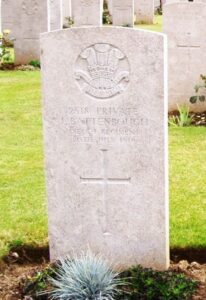
Francis Charles Bennett, Private, 18098, South Wales Borderers. Francis was the son of Frank and Mary Elizabeth Bennett, of New Road, Ynysmudw, Pontardawe. He worked at the Cambrian Mercantile Colliery prior to enlisting at Pontardawe into the 5th Battalion, South Wales Borderers early in the war. The battalion embarked for France on 16 July 1915, as the Pioneer Battalion to the 19th Division. The division took up positions north of Loos, near Givenchy, for trench initiation and from here launched a diversionary assault during the opening day of the Battle of Loos on 25 September 1915, suffering heavy casualties. The division then moved to the Cambrin sector just south of the La Bassée Canal, until being moved to hold the line roughly from east of Festubert to east of Richebourg-l’Avoué, and later moved to positions near La Gorgue. On 14 March 1916 the 5th SWB was in the line at the Duck’s Bill, assisting the 255th Tunnelling Company, Royal Engineers, when the Germans exploded an underground mine, destroying the northern part of the Duck’s Bill salient and killing dozens of men. Francis was killed by a sniper while attempting to rescue some wounded men following the explosion that day. The 26-year-old has no known grave and is commemorated on panel 52 of the Loos Memorial, France.
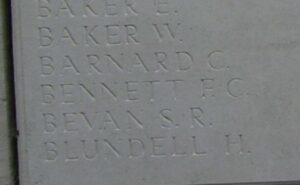
Brinley Richard Bevan, Private, 290206, Welsh Regiment. Brinley was the son of John and Catherine Bevan, of the Vernon Hotel Briton Ferry. His father was from Pontardawe, and Brinley was brought up in the town by relatives before becoming an apprentice electrician at the Gwaun-Cae-Gurwen Colliery. He enlisted at Briton Ferry into the 3rd Battalion, Welsh Regiment on 25 September 1914. On 13 March 1915 Brinley was discharged from the 3rd Welsh on medical grounds, due to poor eyesight (not a good ailment for an electrician), but un-deterred he re-enlisted at Swansea into the 18th Battalion, Welsh Regiment, which was a Bantam battalion, attached to 119 Brigade, 40th (Bantam) Division. The division landed in France in June 1916 and moved to the front near Loos. Late in 1916 it moved south to the Somme, and fought at the Battle of the Ancre, and remained in the area over the winter. In March 1917 the Germans withdrew to their shortened line, called the Hindenburg Line, and the 40th Division was one of the Divisions that followed the withdrawal. Later in the year they took part in the Battle of Cambrai, playing an important role in the attack on Bourlon Wood. The division remained in the area over the coming months, and was caught up in the German Spring Offensive of 21 March 1918, suffering heavily before being sent north to Flanders to rest and rebuild. Unfortunately, in April the Germans launched an offensive in Flanders, and the 40th Division was caught up in the thick of it again, suffering horrific casualties. Brinley was reported as missing during this period of the war. His mother received news that he had been taken prisoner by the Germans, but it was later discovered that he had died in captivity on 11 June 1918, aged 23. He was originally buried in Wavrin German Cemetery, but his grave was lost during the coming months, so today Brinley is commemorated on the Wavrin German Cemetery Memorial, number 23, in Cabaret-Rouge British Cemetery, Souchez, France. His mother later moved to 11, Rugby Avenue, Neath.
William Beynon, Gunner, 118184, Royal Field Artillery. William was the son of Thomas and Margaret Beynon, of Orchard Street, Pontardawe. He married Gwladys Price at Neath in 1916 and she set up the family home at Ty’r-Waun, Rhos, Pontardawe. William enlisted into the Royal Field Artillery and was posted to France with the 56th Battery, 34th Brigade, Royal Field Artillery, which was attached to the 2nd Division. In April 1917, William’s battery was in action during the Battle of Arras, when his officer was killed, and he took over command of the gun before being badly wounded by shrapnel, which struck him in the leg, arm and side. He was evacuated to the 2nd London General Hospital at Chelsea for treatment, but died of wounds there on 28 May 1917, aged 24. His body was brought home and he was buried with full military honours in Pontardawe Welsh Wesleyan Burial Ground. Thousands of people from the town lined the streets from Orchard Street to the chapel to see the first military funeral at Pontardawe.
Trevor Bonham, Lance Sergeant, 2459, Welsh Regiment. Trevor was the son of Benjamin and Margaret Bonham, of Pontardawe. His father was a merchant sailor from Laugharne who had moved to Llansamlet with his parents, and after retiring moved his family to Pontardawe. Trevor was an army regular who had enlisted at Portsmouth into the Welsh Regiment prior to the war. He landed in France on 2 February 1915 and was posted to the 2nd Battalion, Welsh Regiment, which was in Flanders attached to 3 Brigade, 1st Division. The battalion had suffered terrible casualties since landing in France in August 1914, taking part in the retreat from Mons and the Battles of the Marne and the Aisne, before moving to Ypres, and was almost decimated at Gheluveld. By May 1915 the British had decided on an offensive at Aubers Ridge in conjunction with a French assault on Vimy Ridge, to the south, and on 9 May 1915 the Battle of Aubers Ridge began. Trevor was killed in action during the assault, when the 2nd Welsh were decimated by machine-gun fire as soon as they arose from their trenches. The 21-year-old has no known grave and is commemorated on panel 23 of the Le Touret Memorial, Richebourg-L’Avoué, France.
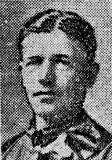
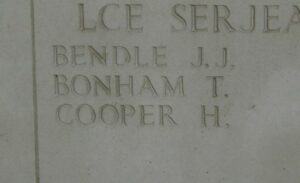
Thomas Bowden, Lance Corporal, 5570, Somerset Light Infantry. Thomas was the son of William and Mary Bowden, of Bristol. He had served with the Somerset Light Infantry during the Boer War, and after leaving the army moved to Pontardawe to work as a brewery labourer. He married Emily Lucy Jacobs on 8 October 1910 and the couple lived at Commercial Road, Rhydyfro, Pontardawe, where their two daughters were born. Thomas re-enlisted into the Somerset Light Infantry at the outbreak of war, but his health broke down and he was diagnosed as suffering from tuberculosis. Thomas was discharged from the army on 5 November 1914, and returned to Pontardawe. Sadly, his wife, Emily, became ill and died in October 1916, and the still grieving Thomas succumbed to tuberculosis and died on 18 December 1916, aged 34. He is buried at St. Peter’s Churchyard, Pontardawe. Unfortunately, Thomas is not commemorated by the CWGC, and is not eligible for commemoration by them, as his pension papers state that his illness had not been brought about by his military service.
Percy Oliver Brown, Private, 17491, South Wales Borderers. Percy was born on 5 December 1887, the son of Joseph and Alice Brown, of Fulham, London. He was an army reservist, residing at Rhydyfro, Pontardawe, when he enlisted into the 5th Battalion, South Wales Borderers early in the war. The battalion embarked for France on 16 July 1915, as the Pioneer Battalion to the 19th Division. The division took up positions north of Loos, near Givenchy, for trench initiation and from here launched a diversionary assault during the opening day of the Battle of Loos on 25 September 1915, suffering heavy casualties. The division then moved to the Cambrin sector just south of the La Bassée Canal, until being moved to hold the line roughly from east of Festubert to east of Richebourg-l’Avoué, and later moved to positions near La Gorgue. The division next saw action during the Battle of the Somme in the summer of 1916, taking part in the capture of the village of La Boisselle. In 1917 the Division moved North to Ypres, taking part in the Battle of Messines, and fought during the later stages of the Third Battle of Ypres. By January 1918 the division was stationed near Ytres, south west of Cambrai. On 30 January the 5th SWB was at work digging trenches near to the village of Ytres, when they were bombarded with gas shells. Percy was one of thirteen men who were badly affected by the gas and were evacuated to hospital, and he sadly died of gas poisoning at Étretat on 8 February 1918, aged 30. He is buried in grave II.B.1. in Étretat Churchyard Extension, France.
Edward Dale, Private, 13178, Devonshire Regiment. Edward was the son of Edward and Elizabeth Dale, of High Street, Llandovery. He had resided with Mr Will Jones, of 25, Railway Terrace, Alltwen, for 14 years prior to the war. Edward enlisted at Tonyrefail into the 10th Battalion, Devonshire Regiment, which was attached to 79 Brigade 26th Division. The Division landed at Boulogne on 23 September 1915 but were soon moved again, arriving in Salonika during November that year. Here they fought in the Salonika Campaign against the combined Bulgarian and Turkish forces, and it was here on 25 April 1917 that Edward was killed in action. He was 32 years old, and is remembered on the Doiran Memorial, Salonika.
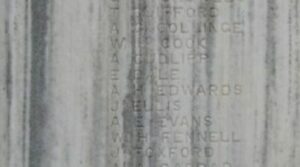
David Daniels, Private, 37629, Royal Welsh Fusiliers. David was the son of John and Elizabeth Daniels (sometimes spelt Daniel), of Banwen, Alltwen. He worked at Gilbertson’s Tinplate Works prior to enlisting at Swansea into the Royal Welsh Fusiliers, and was posted to France in 1916, joining the 2nd Battalion, Royal Welsh Fusiliers. The battalion was, at that time, attached to 19 Brigade, 33rd Division, and was on the Somme, having moved from the Cambrin area on 7 July 1916. The 2nd RWF were thrown into the fighting for High Wood within days of their arrival on the Somme, and took part in heavy fighting over the coming weeks before moving to the St. Pol area for a rest period early in September. After a long and enjoyable period in reserve, on 19 October the 2nd RWF began to move back towards the front line, at Morval, reaching their positions near Sailly-Saillisel on 23 October 1916, alongside the French. After several arduous days of digging in, on 27 October 1916 David was killed in action here, during a pouring wet, miserable day. The 20-year-old has no known grave and is commemorated on pier and face 4A of the Thiepval Memorial, France.
John Daniels, Private, 34477, Welsh Regiment. John was the son of Evan and Hannah Daniels (sometimes spelt Daniel), of Gravel Bank, New Road Ynismeudw, Pontardawe. He worked as a collier prior to emigrating to Canada, and returned home following the outbreak of war to enlist at Cardiff into the Welsh Regiment. John was posted to the 9th Battalion, Welsh Regiment, landing in France with the battalion on 18 July 1915. The battalion was attached to 58 Brigade, 19th (Western) Division and moved to the Neuve-Chapelle area for trench initiation. The 19th Division was ordered to carry out a diversionary attack at Givenchy, to attempt to divert German resources away from the main battle area of Loos village, during the planned Battle of Loos. The offensive was launched at dawn on 25 September 1915, but with the British gas cover blowing onto the troops, coupled with concentrated German machine-gun fire, the 19th Division was mown down. John was among hundreds of men from the division who were killed during the opening minutes of the battle that day. The 22-year-old is buried in grave V.E.16. in Guards Cemetery, Windy Corner, Cuinchy, France.

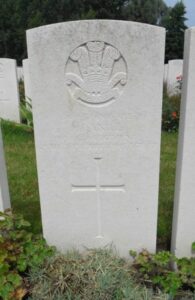
Aaron Davies, Private, 20812, Royal Warwickshire Regiment. Aaron was born in Pontardawe in 1889, the son of Morgan and Ann Davies, of Gellygron, Pontardawe. He married Harriet Davies at Pontardawe in 1913 and the couple moved to 18, Tan-y-Fron, Garden Suburb, Barry. Aaron enlisted at Swansea into the Welsh Regiment, and later transferred into the 1/5th Battalion, Royal Warwickshire Regiment, who were attached to 143 Brigade, 48th (South Midland) Division. The Division was a formation created by the establishment of the Territorial Force in 1908. It moved to France between 22 March and 1 April 1915, and saw its first major engagement at the opening of the Battle of the Somme. The Division held the line between the 56th (London) and the 31st Divisions, both of which were heavily engaged at Gommecourt and Serre respectively. Two of the battalions of the Division attacked on 1 July 1916, and suffered heavy casualties. They then went into action at the Battle of Bazentin, during the second phase of the Battle of the Somme, and captured Ovillers. Aaron was killed in action at Bazentin Ridge on 18 July 1916, aged 27. He has no known grave and so is commemorated on pier and face 9A, 9B and 10B of the Thiepval Memorial, France.

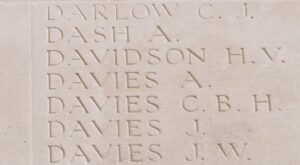
Arthur Carey Davies, Private, 8304, Welsh Regiment. Arthur was the son of David and Sarah Davies, of Pontardawe. He had served in the army for several years before joining the army reserve and returning to Pontardawe to become a bricklayer at Gilbertson’s Works, and married Margaret Grills, of 1, Mayfield Street, Cwmbwrla, Swansea in 1910. Arthur re-enlisted at Swansea at the outbreak of war and embarked for France with the 2nd Battalion, Welsh Regiment on 13 August 1914, taking part in the retreat from Mons, the battles of the Marne and Aisne, and the heroic defence of Gheluveld later that year, which saw him shot in the leg. Arthur was evacuated to the 4th Western Hospital at Lincoln, before being hospitalised in Manchester where he spent several months recovering from his wounds. Upon recovering, he was posted to the 8th Battalion, Welsh Regiment, which was the Pioneer battalion to the 13th (Western) Division. He joined up with the division in Egypt following its evacuation from the Gallipoli peninsula, and embarked with the Division for Mesopotamia, as a result of the need to relieve General Townshend’s besieged troops at Kut. Arthur died of heatstroke in Mesopotamia on 22 June 1916. The 37-year-old is buried in grave VI.O.9. in Basra War Cemetery, Iraq.
Benjamin Davies, Private, 39072, South Wales Borderers. Benjamin was the son of William and Gwenllian Davies, of Penywaun, Rhos, Pontardawe. He enlisted at Pontardawe into the Brecknock Battalion, South Wales Borderers, and was posted to France at some time in 1916, joining the 1st Battalion, South Wales Borderers, which was attached to 3 Brigade, 1st Division. He saw his first action with the division during the Battle of the Somme that summer, where the 1st Division took part in some terrible fighting around Munster Alley. The Division followed the German retreat to the Hindenburg Line in early 1917, and was then briefed for an operation on the Flanders Coast, moving there to Le Clipon Camp during the summer of 1917. When the Third Battle of Ypres stalled in the mire, the Division was recalled to Ypres, to take part in the Second Battle of Passchendaele, the final assault on the ridge. By 8 November 1917 the 1st SWB had reached Irish Farm, and the men were shocked at the state of the battlefield in front of them. Orders were received on the following day for the battalion to assault German held positions and pill-boxes around Goudberg Copse. The assault was launched at zero hour on 10 November 1917, and the attacking troops managed to gain contact with the Canadians on their flank. Heavy fighting raged throughout the day, and it was at some time during this maelstrom on 10 November 1917 that Benjamin was killed in action. The 21-year-old has no known grave and is commemorated on panel 65-66 of the Tyne Cot Memorial, Belgium. He is also reportedly commemorated on a memorial plaque within Ebenezer Chapel, at Rhos.
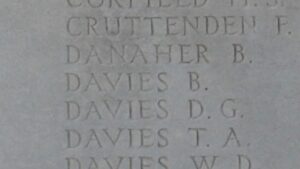
Daniel Edward Davies, Private, 355773, Royal Welsh Fusiliers. Daniel was the son of John and Jane Davies, of Morriston. Following the death of his father in 1884, Daniel was raised by an aunt and uncle. He lived at 21, Beacon Road, Pontardawe prior to the war worked as a foreman timberman prior to enlisting at Newtown into the Welsh Horse Yeomanry on 20 January 1915. He was posted to Gallipoli to join the 1st/1st Battalion, Welsh Horse, and landed on the peninsula on 25 December 1915, just prior to the evacuation. On 16 December 1916 he transferred to the 25th Battalion, Royal Welsh Fusiliers, following the merging of the Montgomery and Welsh Horse Yeomanry battalions, and became attached to 231 Brigade, 74th (Yeomanry) Division. This newly formed division saw its first action during the Second Battle of Gaza between 17-19 April 1917. It then took part in the Third Battle of Gaza on 1 November 1917, before helping drive the Turkish troops slowly northwards, capturing Jerusalem on 9 November. On 29 November 1917 the commanding officer of the 25th RWF, Lord Kensington, received orders to take over the line from Hill 1750 to the village of Beit Ur el Foka. Daniel was killed on the following day, 30 November 1917, whilst the battalion was fighting in difficult terrain, attempting to attain their objectives. The 36-year-old has no known grave and is commemorated on panels 20-22 of the Jerusalem Memorial, Israel.
David Davies, Private, 29029, Welsh Regiment. David was the husband of Lily May Davies (nee Brookes), of Cilmaengwyn Road, Ynysmudw, Pontardawe. He enlisted at Swansea into the 14th Battalion, Welsh Regiment (Swansea Pals), and was posted to France in 1916, joining the 10th Battalion, Welsh Regiment (1st Rhondda), which was in Flanders attached to 114 Brigade, 38th (Welsh) Division, alongside the 14th Welsh. The division spent its early months on the front holding various sectors in the area between Givenchy and the La Bassée canal, and in June 1916 marched south, in order to take part in the Somme offensive. On 7 July the division launched its first assault on the strongly defended Mametz Wood, using just one brigade, but the attacking battalions were mown down. Following the sacking of the divisional commander, General Sir Ivor Philipps, the division attacked again on 10 July 1916, and the 10th Welsh advanced into the Hammerhead section of the wood where they fought hand to hand against the German defenders. David was killed in action here on 10 July 1916. The 36-year-old has no known grave and is commemorated on pier and face 7A and 10A of the Thiepval Memorial, France.
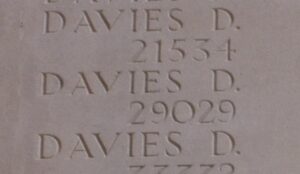
John Davies, Private, 14219, Welsh Regiment. John was born in Pontardawe, and was the brother of William Davies, of The Green Neck, Neath. He enlisted at Cardiff into the Welsh Regiment, and was posted to France on 3 December 1914 to join the 2nd Battalion, Welsh Regiment, which was near Ypres attached to 3 Brigade, 1st Division. The division had been in the thick of the action since arriving at the front in August 1914, and during 1915 took part in the Battle of Festubert, and then the Battle of Loos from September onwards. In June 1916 the division began moving away from the Loos sector and moved south to the Somme, in order to take part in the Somme offensive and on 15 July the 2nd Welsh marched from billets at Albert and arrived at the south of Bazentin Wood, from which they moved into the front line. Over the coming days the battalion suffered a number of casualties whilst carrying out bombing attacks against the Germans. The 1st Division remained in the line, south of Pozieres, over the coming days, pressing the Germans while the Australians launched their attack on the village on 23 July, and the 2nd Welsh took part in heavy fighting during this period. By the middle of September the line had pushed forwards to Morval. John was killed in action on 23 September 1916 during the drive to capture Morval. He is buried in grave III.H.14. in Bulls Road Cemetery, Flers, France. He was possibly 44 years old at the time of his death.
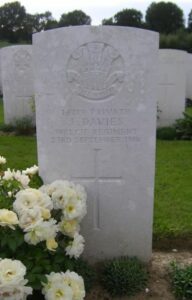
John Howard Davies, Second Lieutenant, South Wales Borderers. John was the son of John Philip Davies and Priscilla Anne Davies, of Bron-y-Coed, Pontardawe. He was educated at Bishop’s Stortford College and was commissioned from the Inns of Court OTC into the South Wales Borderers on 19 December 1916. John was then posted to France, where he was attached to the 2nd Battalion, South Wales Borderers. The battalion had arrived at Marseilles from Egypt on 15 March 1916, after service in China and Gallipoli, attached to 87 Brigade, 29th Division, and had suffered terrible casualties during the assault on Y-Ravine on 1 July 1916. In the Spring of 1917 the division had moved north and fought at the Battle of the Scarpe, which was part of the Arras Offensive, before moving further north to Ypres, relieving the 38th (Welsh) Division north of Ypres, so the latter could train in readiness for the forthcoming Third Battle of Ypres. On the night of 4-5 July 1917, John took charge of a patrol, and soon after leading his men out of their trench came into contact with a German patrol on No Man’s Land. After a brief but fierce fight, both parties withdrew, but John had been badly wounded. He died soon afterwards, aged only 22, and is buried in grave II.J.5. in Bard Cottage Cemetery, Belgium.
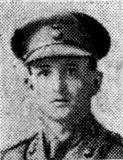
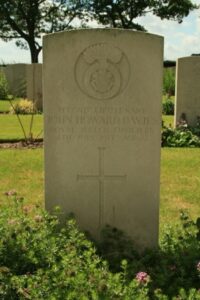
Reginald Leslie Davies, Sapper, 157938, Royal Engineers. Reginald was born at Haverfordwest in 1891, the son of Thomas Herbert Davies and Elizabeth Anne Davies. By 1901 the family had moved to 10, Ynysderw Road, Pontardawe. Reginald enlisted at Cardiff into the Royal Engineers, and served with the 180th Tunnelling Company. The Tunnelling Companies had been formed in response to German tunnelling during 1915. They were used to dig mines beneath German positions, to dig dugouts and shelters for troops, and for other similar work. Reginald was killed while his Company was at Arras on 10 August 1916, probably whilst digging the tunnels and mines ready for the forthcoming Arras Offensive the following year. He was 25 years old and has no known grave, and so is commemorated on bay 1 of the Arras Memorial, France.
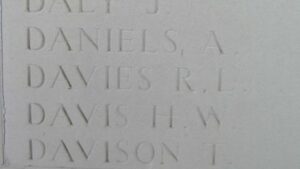
Robert Benjamin Davies, Private, 48870, Lancashire Fusiliers. Robert was the son of John and Hannah Elizabeth Davies, of 12, Gwyn Street, Alltwen, Pontardawe. He was employed at Messrs Gilbertson’s Works, Pontardawe prior to enlisting in Pontardawe into the Middlesex Regiment. When he was posted to France, Robert transferred to the 10th Battalion, Lancashire Fusiliers, serving in A Company. The battalion was attached to 52 Brigade, 17th (Northern) Division and had seen its first action near Ypres, at the Bluff, during February 1916. Its next major action was during the opening of the Somme offensive, when the division captured Fricourt at heavy cost. It moved north the following year and saw action during the Battle of Arras, at the First and Second Battles of the Scarpe and the Capture of Roeux, before moving to Ypres, and took part in the First and Second Battles of Passchendaele. In March 1918 the Division was on the Somme, and faced the German Spring Offensive there. After a period out of the line to rest and rebuild, the Division moved to the southernmost sector of the Somme area, where they fought at the Battle of Amiens on 8 August 1918, a day which saw the war swing in the favour of the Allies. The Allies then advanced on the Somme, and was fighting around Bapaume when Robert was killed in action, on 25 August 1918. The 24-year-old has no known grave and is commemorated on panel 5-6 of the Vis-en-Artois Memorial, Haucourt, France.
Samuel Evan Davies, Private, 18310, South Wales Borderers. Samuel was the son of Evan and Gwen Davies, of Swansea Road, Trebanos. He enlisted at Pontardawe into the 5th Battalion, South Wales Borderers, which was the pioneer battalion of the 19th (Western) Division, and landed in France with the battalion on 17 July 1915. The division initiated in trench warfare in the Givenchy area before taking part in an ill-fated diversionary attack during the opening of the Battle of Loos on 25 September 1915. It took part in the opening assault of the Somme offensive, and saw heavy fighting throughout the Battle of the Somme, before moving to the Ploegsteert area, and taking part in the Battle of Messines the following year. The division then fought in the latter stages of the Third Battle of Ypres, before being moved to the Hindenburg Line area, where it was hot during the German spring offensive of 21 March 1918. Following heavy losses, the division was moved back to the Messines area, where it was hit hard by a second German offensive, at the Battle of the Lys, on 10 April, and was then sent to the Champagne sector to rest. Unfortunately the Germans launched their third offensive in this sector in May 1918, and the 19th Division were again caught up in heavy fighting. On 30 May 1918 the 5th SWB moved from Ham to Chambrecy, before going forward to dig a new line, behind Romigny, but got caught by murderous German artillery fire and sustained heavy casualties before being forced to withdraw. Samuel was killed in action during the shelling. The 26-year-old is buried in grave V.C.3. in Chambrecy Military Cemetery, France.
William Evan Davies, Private, 267445, Monmouthshire Regiment. William was the son of Thomas and Margaret Davies, of 1, Brynhyfryd Terrace, Cefn Coed, Merthyr Tydfil. He moved to Ynismeudwy to work at the Tarreni Colliery, Godre’rgraig. He enlisted at Brecon during January 1915 into the Monmouthshire Regiment, and was posted to France in 1916, joining the 2nd Battalion, Monmouthshire Regiment, which was by then the pioneer battalion to the 29th Division. The Division took part in its first major action in France during the 1916 Somme Offensive, and fought at the Battles of Albert and Le Transloy, suffering heavy casualties. In the Spring of 1917 it fought at the Battle of the Scarpe, which was part of the Arras Offensive. On 4 May 1917 the 2nd Monmouths were working on road repairs near Arras, when they came under fire from German artillery. William was struck by shrapnel which mortally wounded him, and he died within minutes. The 21-year-old is buried in grave IV.F.31. in Fauborg D’Amiens Cemetery, Arras, France. His mother, who had by then been widowed and become dependent on William, learned of his death through the following letter, written by an officer of the battalion: ‘Dear Mrs Davies. I am very sorry to have to inform you that your son, No. 267445 Pte. W. E. Evans, was killed on the 4th inst. He was hit by a large shell, and died a few minutes after- wards. I am sure he suffered no pain, as he was unconscious to the end. Both officers and men of his company tender you their sympathies in your great loss. Your son was an excellent asset to the company; he always did his duty cheerfully under the most trying conditions, and was an example to others. I need hardly say that we are all sorry to lose such a good soldier. I trust you will find consolation in the fact that he died fighting for the greatest of all causes.’ (The CWGC shows his date of death as 6 May, but the war diary confirms the officers letter).
Frank Beresford Douglas, Rifleman, R/16388, King’s Royal Rifle Corps. Frank was from Sheffield, but prior to the war had moved to south Wales to find work, and lived at 8, Church Road, Pontardawe. On 31 August 1914 he enlisted into the King’s Shropshire Light Infantry, but on 24 October was discharged after being found to be unlikely to become an efficient soldier. Undeterred, on 8 November 1915 he re-enlisted at Swansea, joining the King’s Royal Rifle Corps, and on 8 March 1916 was sent to France, joining the 12th Battalion, King’s Royal Rifle Corps, which was attached to 60 Brigade, 20th (Light) Division. The division moved to the Somme in July 1916 and relieved the 38th (Welsh) Division at Hébuterne. By 22 August the 20th Division had moved south to the area south of Delville Wood, and took part in the Battle of Guillemont. After a brief rest spell, the division moved back into the line on 16 September 1916, alongside the Guards Division, in order to take part in the next phase of the offensive, against the strongly defended village of Lesbouefs. Frank was killed in action during the terrible fighting which followed, on 18 September 1916. The 20-year-old has no known grave and is commemorated on pier and face 13A-13B of the Thiepval Memorial, France.
Ernest Dudderidge, Gunner, 76941, Royal Garrison Artillery. Ernest was born in Trull, Somerset, the son of Mark John Dudderidge and Emily Dudderidge (nee Chubb). At some time after 1911 the family moved to Alltwen, Pontardawe. Ernest enlisted at Cardiff into the Royal Garrison Artillery, and was posted to Hong Kong with the 88th Company, Royal Garrison Artillery. Little else is known of him, but he died in Hong Kong on 7 November 1916, aged 25, and is buried in grave 3.8186 in Hong Kong Cemetery, China.
Roger Howell Edwards, Private, 63323, Canadian Infantry. Roger was born on 22 August 1888, the son of Edward and Gwenllian Edwards, of 42, Herbert Street, Pontardawe. He worked as a clerk to the Pontardawe Board of Guardians prior to emigrating to Canada in 1913. He enlisted at Quebec on 19 November 1914 into the 4th Battalion, Canadian Infantry, which was attached to the 1st (Canadian) Brigade, 1st (Canadian) Division. The Division arrived in Britain on 14 October 1914 and moved to Salisbury Plain. It embarked for France during February 1915 and moved to positions at Ypres. The divisions first taste of a major battle soon came on 22 April 1915, when French Colonial troops at Gravenstafel were smothered in clouds of chlorine gas, which the Germans had released for the first time in the war. The terrified survivors fled, leaving a 4-mile gap in the line. The Canadians were ordered to counter-attack and managed to stop the German advance, which had reached the village of St. Julien. On 24 April the Germans attacked again, behind another cloud of gas, and the Canadians took part in desperate fighting. Roger was gassed during the fighting here on 2 May 1915, and was found lying on the battlefield, struggling to breathe. He was rescued and brought home for treatment, and spent time at Fulham Military Hospital, before being transferred to the Red Cross Hospital, Taplow, where he spent three months before being transferred to Hillingdon House, Uxbridge, and then to the Central Hospital Shorncliffe, from where he was discharged and returned home. He died as a result of bronchial and cardiac failure at Herbert Street on 23 December 1916, which had been brought about by his being gassed. The 28-year-old was buried with full military honours in Pontardawe (All Saints) Churchyard.
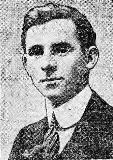
Henry Herbert Evans, Private, 15535, South Wales Borderers. Henry was the son of Harry Walter Evans and Sarah Ann Evans, of The Cottage, Railway Terrace, Pontardawe. He enlisted at Ystradgynlais into the Brecknock Battalion, South Wales Borderers on 15 October 1914, and was posted to France on 30 July 1916, joining the 2nd Battalion, Monmouthshire Regiment on the Somme, where it was attached to the 29th Division as its pioneer battalion. Henry was only at the front for two months when he took ill and was brought to the 87th Field Ambulance for treatment. He died there of exposure on 21 October 1916, aged 22. For some reason Henry does not have a known grave, so he is commemorated on pier and face 4A of the Thiepval Memorial, France.
John Evans, Private, 235166, Yorkshire Regiment. John was born at Pontardawe. He enlisted at Cardiff into the army and was posted to France in 1916, joining the 4th Battalion, Yorkshire Regiment (Green Howards), which was attached to 150 Brigade, 50th (Northumbrian) Division. During the summer of 1916 the Division was on the Somme, where it fought at the Battle of Flers-Courcelette, the Battle of Morval and the Battle of Le Transloy. After spending a winter on the Somme, it moved north to Arras, where it took part in the Arras Offensive of April 1917, and fought at the First Battle of the Scarpe, capturing the Wancourt Ridge. John was killed in action here on 23 April 1917. He has no known grave and is commemorated on bay 5 of the Arras Memorial, France.
William Foley, Lance Sergeant, 31800, South Wales Borderers. William was the son of Maurice and Eleanor Foley, of 64, Bethania Street, Maesteg. He married Agnes Mary MacNamara in Neath in 1907 and the couple lived at Tan-yn-allt, Trebanos, where he served as a police sergeant. William enlisted into the Rhondda Battalion, Welsh Regiment soon after the outbreak of war, and was among around 200 men transferred to the 15th Battalion, Welsh Regiment (Carmarthen Pals), at Rhyl. He was subsequently transferred to the 11th Battalion, South Wales Borderers, joining the battalion in France at some time in 1916, where it was attached to 115 Brigade, 38th (Welsh) Division. William probably joined the battalion after its ordeals at Mametz Wood, and would have served at Ypres, where the division held the canal bank north of the city, following its move from the Somme. He was wounded, most likely during the Battle of Pilckem Ridge, and evacuated via the chain of clearing stations, to Britain and was hospitalised at the War Hospital, Napsbury, St. Albans, where he died of his wounds on 10 December 1917, aged 34. His body was brought home and he was buried in Clydach-on-Tawe (St. John the Baptist) Churchyard, in grave 184. His brother Thomas had died in 1915 whilst serving with the 12th Welsh, but is not commemorated on the Pontardawe War Memorial, even though he had lived with William for several years prior to marrying and moving to Post Talbot and had enlisted alongside him into the Rhondda Battalion.
David Thomas Francis, Driver, 113069, Royal Field Artillery. David was the son of David and Priscilla Francis, of Savon Place, Rhydyfro, Pontardawe. He enlisted at Swansea into the Royal Field Artillery and was posted to France with the 41st Division Ammunition Column, Royal Field Artillery. The division moved to France by 6 May 1916, and began familiarisation with trench warfare in the areas of Ploegsteert and the Douve valley, south of Ypres. It remained here until August 1916, when it moved to the Somme, and took part in the Battle of Flers-Courcelette. The Division remained in the line, pushing on to Courcelette over the next few days before coming out for a rest and re-fit. The division then fought at the Battle of Le Transloy, before moving to positions south of Ypres in 1917. Here it took part in the Battle of Messines, before moving further north, where it fought at the Battle of Pilckem, and the Battle of the Menin Road, as part of the Third Battle of Ypres. David was killed in action at Ypres on 27 September 1917, aged 24. He is buried in grave VII.C.18. in The Huts Cemetery, Belgium.
George Gardiner, Driver, T/13939, Royal Army Service Corps. George was the son of William and Elizabeth Gardiner, of Canon Pyon, Herefordshire. He married Catherine Lewis, of Gwyn Street, Alltwen, Pontardawe, in 1908, and the couple had four children. He worked as a coal miner prior to enlisting at Pontardawe into the Army Service Corps, and was posted to France on 23 June 1915. George served in France until becoming ill in the late summer of 1917, and was brought back to Britain before being sent to the Military Hospital in Belfast for treatment. He died of sickness there on 27 December 1917, aged 32. His body was brought home to Alltwen, and he was given a burial with full military honours in Alltwen Welsh Congregational Chapelyard.
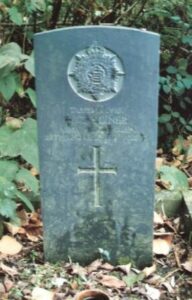
William Gibbs, Private, 12862, South Lancashire Regiment. William was the son of Thomas and Margaret Gibbs, of 4 Bryntawe Cottages, Derwen Road, Alltwen, Pontardawe. He had served with the 7th Welsh prior to the war and enlisted at Swansea on 29 August 1914 into the 6th Battalion, South Lancashire Regiment. The battalion was attached to 38 Brigade, 13th (Western) Division, and embarked at Avonmouth in June 1915 for service at Gallipoli, landing at Cape Helles on 7 July 1915. The division was evacuated to Mudros a week later before landing at Anzac Beach on 4 August 1915. William was shot in the skull on Gallipoli and was evacuated to hospital in Malta, where he died of his wounds on 18 August 1915, aged 25. He is buried in grave B.VI.6. in Pieta Military Cemetery, Malta.
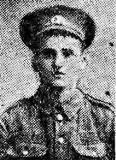
David Ivor Griffiths, Private, 29233, Welsh Regiment. David was the son of John and Sarah Griffiths, of Graig Road, Trebanos. He worked at Gilbertson’s Works prior to the war, and married Dinah Parton at Pontardawe early in 1915. David enlisted in Swansea into the Welsh Regiment and was posted to the 14th Battalion, Welsh Regiment (Swansea Pals), which was attached to 114 Brigade, 38th (Welsh) Division. The battalion moved to France on 2 December 1915 and the entire division moved to the nursery sector at Fleurbaix for trench initiation. On 14 April 1916 the 14th Welsh relieved the 15th Welsh in the Festubert front line trenches, to begin a four day tour of duty. David was killed in action during the relief that day. He was 27 years old and is buried in grave II.E.19. in Brown’s Road Military Cemetery, Festubert, France.
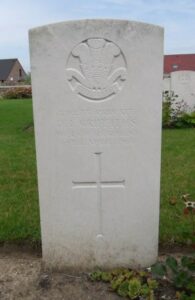
Albert Edward Hall, Gunner, 117118, Royal Field Artillery. Albert was the son of John and Sarah Hall, of 8, Anchor Street, Taffs Well, Cardiff. He was a butcher who lived at 13 George Street, Pontardawe prior to the war. Albert enlisted at Swansea into the Royal Field Artillery and was posted to France with A/181st Brigade, Royal Field Artillery, which was attached to the 40th (Bantam) Division. The Division moved to France during the first week of June 1916, and moved to the front near Loos. Late in 1916 it moved south to the Somme, and fought at the Battle of the Ancre, during the latter phase of the Battle of the Somme. Albert was wounded towards the end of the year, and died of his wounds on 19 December 1916, aged 32. He has no known grave and is commemorated on pier and face 1A and 8A of the Thiepval Memorial, France.
Benjamin John Hatch, Private, 16944, Somerset Light Infantry. Benjamin was the son of Thomas and Sarah Hatch, of Pontardawe. He lived with his half-brother William Temblett at Graig Road, Alltwen, Pontardawe, prior to marrying Lily Steward in 1913, and the couple lived at Orchard Street, Pontardawe. Benjamin worked at the Pontardawe Brewery prior to enlisting at Swansea into the Somerset Light Infantry and was posted to the 8th Battalion, Somerset Light Infantry, landing in France on 8 September 1915. The battalion was attached to 63 Brigade, 21st Division and although inexperienced, was placed in reserve for the British assault at Loos, where it was sent into action on 26 September, and suffered over 3,800 casualties for very little gain. It remained in the sector over the winter. On 19 November 1915 a patrol from Benjamin’s battalion was out in No Man’s Land when it came under fire from the Germans. One of the officers fell wounded, and Benjamin rushed out to drag one back into safety. He wrote a letter back to his wife telling her of the incident, but before it reached her, on 24 November 1915, he was killed in action by shrapnel from a bursting shell while in the front line. His body was brought back for burial in grave C.2. in Chapelle-D’Armentieres New Military Cemetery, France.
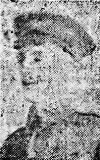
Michael Healy, DCM, MM and Bar, Sergeant, 5130, Royal Munster Fusiliers. Michael was the son of Annie Healy, of Ballinamuck, Dungarvan, County Waterford. He worked at Gilbertson’s Works, Pontardawe prior to the war and enlisted at Swansea into the Royal Munster Fusiliers. He was posted to France on 24 May 1915, joining the 2nd Battalion, Royal Munster Fusiliers, which was attached to 3 Brigade, 1st Division. The division had just been heavily involved in the Battle of Aubers, before moving South to Loos, where it fought during the Battle of Loos, and the action at the Hohenzollern redoubt. In July 1916 the division marched south to the Somme, and took part in heavy fighting during the Battles of Bazentin, Pozieres, Flers-Courcelette and Morval. By the end of the Somme offensive, Michael had gained three gallantry awards: the DCM, MM and a Bar to his MM. The citation to his DCM was published in the London Gazette of 22 September 1916, and stated: ‘For conspicuous gallantry in stemming with a few others, an enemy onrush with bombs and, subsequently, led a counter-attack, which succeeded in reaching the objective.’ Following the closure of the Somme offensive, the division followed the German retreat to the Hindenburg Line in early 1917. Michael was badly wounded on 1 March 1917 when attempting to pick up a live hand grenade which a fellow soldier had thrown but has bounced back into the trench and exploded in his hand. He died of his wounds on the following day, 2 March 1917, aged 25. Michael is buried in grave II.B.53. in Bray Military Cemetery, France.
Albert Edward Hewer, Private, 7717, Gloucestershire Regiment. Albert was born in Wootton Bassett in 1881, the son of Robert Hewer and Louisa Hewer, née Nichols, of Wood Street. Albert enlisted into the Gloucestershire Regiment on 16 August 1904 and served with the 2nd Battalion. He had left the army prior to 1911, becoming a reservist, and lived at 1, Ynysmeudwy Road, Pontardawe, where he worked as a masons labourer at Gilbertson’s Works. Following the outbreak of war he re-enlisted into the 1st Battalion, Gloucestershire Regiment, and joined the battalion at Bordon, where it was attached to 3 Brigade, 1st Division. The division landed at Le Havre on 13 August 1914 and joined the BEF at Mons, taking part in the epic retreat from Mons to the Marne, and fought in the subsequent battles of the Marne and Aisne, before being transferred to positions east of Ypres, to defend the city against the German drive towards the Channel coast. Albert was wounded during the Battle of the Aisne and was hospitalised at the 2nd Southern General Hospital in Bristol. He re-joined his battalion in reserve at Outtersteene some weeks afterwards. Early on 20 December 1914 the 1st Gloucesters received orders to prepare to move to the front near Givenchy, following a German attack upon the Indian Corps. The battalion marched to Merville during the day and on the 21st marched to Bethune before moving into the Givenchy front and attacked from Festubert where the 1st Division attacked to attempt to regain trenches lost by the Indians. After heavy fighting, the 1st Gloucesters were relieved on the 24th, after suffering terrible losses. Albert was reported missing and was later confirmed as having been killed on 23 December 1914. The 33-year-old has no known grave and is commemorated on panel 17 of the Le Touret Memorial, Richebourg-L’avoue, France.
Benjamin Hodge, Stoker 1st Class, SS/116204, Royal Navy. Benjamin was born on 10 April 1894, the son of Thomas Hodge and Hanna Hodge (nee Hawkins), of Court Lane, Pontardawe. He enlisted into the Royal Navy on 31 October 1914 and trained at HMS Vivid II before being posted aboard the armoured cruiser, HMS Defence, on 10 January 1915. He married Mary Williams, of Brynhygod, Trebanos in the spring of 1916 whilst home on leave. He re-joined Defence at its moorings at Scapa Flow, where it was based with the Grand Fleet. After intercepting radio signals that the German High Seas fleet was venturing into the North Sea, on 31 May 1916 the Grand Fleet sailed from Scapa Flow to intercept and engage their enemies. Defence was stationed in front of the main body of the Grand Fleet, along with the remainder of the First Battle-cruiser Squadron, and came across a German scouting group, opening fire. The Germans turned away, but the squadron then came across the disabled German light cruiser SMS Wiesbaden and closed to engage, but were spotted by the German battlecruiser SMS Derfflinger and four battleships. Heavy fire poured down on Defence, which exploded and sank at 06.20 with the loss of all her crew of around 900 men. Benjamin, who was 22-years-old, has no known grave and is commemorated alongside his shipmates on panel 16 of the Plymouth Naval Memorial, Devon.

William John Hopkins, Gunner, 97817, Royal Garrison Artillery. William was the son of Rees and Ann Hopkins, of Edward Street, Alltwen, Pontardawe. Following the death of their parents in 1899, William and his siblings were raised by their elder sister, Hannah, at 4, Railway Terrace, Alltwen. William enlisted at Pontardawe into the Royal Garrison Artillery and was posted to France on 6 December 1916 with the 212th Siege Battery, Royal Garrison Artillery. William was among six men killed when a German shell crashed into their gun-pit on 8 June 1917.He was 31 years old and is buried in grave III.A.4. in Bully-Grenay Communal Cemetery, British Extension, France.
Henry George Howells, Rifleman, 1976, Royal Irish Rifles. Henry was born at Kidwelly in 1896, the son of George and Sarah Ann Howells. The family lived at 7, Francis Terrace for over ten years prior to moving to High Street, Pontardawe, and Henry enlisted there into the Welsh Regiment. He was then posted to the 6th Battalion, Royal Irish Rifles, which was attached to 29 Brigade, 10th (Irish) Division. The Division embarked at Liverpool on 9 July 1915, and on 6 August 1915 landed on Gallipoli at Suvla Bay, less 29 Brigade, which went to ANZAC Cove. At the end of September, the Division evacuated to Mudros, and moved to Salonika, landing there from 5 October 1915. On 18 August 1917 the Division was ordered to concentrate at Salonika for embarkation, and moved to Egypt by 16 October 1917. The Division was then involved in the Palestine campaign. Henry was wounded in Palestine, and died at Jerusalem on 17 June 1918, aged 22. He is buried in grave P.37. in Jerusalem War Cemetery, Israel.

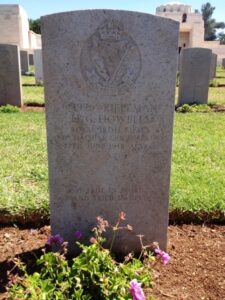
Wilfred Stinton Hudson, Private, 67503, Devonshire Regiment. Wilfred was the son of Robert Samuel and Mary Ann Hudson, of Harrys Yelde, Lindridge, Tenbury, Worcestershire. He lived at 24, Herbert Street, Pontardawe prior to the war, and worked for his brother William as a grocer, before enlisting at Swansea into the Devonshire Regiment. He was posted to France, joining the 5th Battalion, Devonshire Regiment, which had returned from service overseas in 1917, to join 232 Brigade, 75th Division, and landed at Marseilles on 1 June 1918, when it transferred to 185 Brigade, 62nd (2nd West Riding) Division. The division took part in the 100 days offensive, which was launched following an important victory at Villers-Brettoneux on 8 August 1918, and began its advance towards then Hindenburg Line when the general advance begun on 21 August. By 10 September 1918 the division was advancing near Havrincourt Wood, with 185 Brigade in reserve at Frémicourt. On the morning of 12 September 1918, the two other brigades of the division assaulted Havrincourt, and after heavy fighting two companies of the reserve brigade were sent forward. Wilfred must have been among those men sent forward to assist the assault, and was killed in action that day. The 20-year-old has no known grave and is commemorated on panel 4 of the Vis-en-Artois Memorial, Haucourt, France.
William Jacobs, Private, 35180, Wiltshire Regiment. William was the son of Henry Jacobs, of Old Court, Wootton Bassett, Wiltshire. By 1911 the family was living at 1 Cofnllan Villas, Ynysmeudw. William enlisted at Swansea into the Wiltshire Regiment and was posted to France at some time in 1917, joining the 1st Battalion, Wiltshire Regiment, which was attached to 7 Brigade, 25th Division. The division was in the Laqnicourt sector, North East of Bapaume at the beginning of 1918, and on 21 March 1918 was in reserve at Achiet-Le-Grand when the Germans launched their spring offensive. The 1st Wiltshire’s took part in heavy fighting over the following six days, which Captain Hayward MC of the battalion gain the Victoria Cross. The depleted division was then transferred to positions east of Ploegsteert Wood to rebuilt, but was hit by a new German offensive in the Lys valley. William was killed in action during heavy fighting in the area on 12 April 1918, aged 19. He has no known grave and is commemorated on panel 8 of the Ploegsteert Memorial, Belgium.
David Jenkins, Ordinary Seaman, Wales/Z/3432, Royal Naval Volunteer Reserve. David was the only son of William and Mary Jenkins, of the Colliers Arms, Trebanos. He enlisted into the Royal Naval Volunteer Reserve and was posted aboard the steamship SS Minorca. On 11 December 1917 Minorca was on a voyage from Genoa to Carthagena, when she was torpedoed and sunk by the German submarine U-64, with the loss of all her crew of fifteen men. David was 22 years old when he died that day and is commemorated alongside his shipmates on panel 25 of the Plymouth Naval Memorial, Devon.
James Jenkins, MM, Lance Bombardier, 92957, Royal Garrison Artillery. James was the son of William and Mary Jenkins, of Church Villa, Cilybebyll. He worked as a tinworker prior to enlisting at Pontardawe on 10 December 1915 into the Royal Garrison Artillery. He was on the army reserve for twelve months before being mobilised on 11 December 1916 and was posted to France on 18 December, joining the 61st Siege Battery, Royal Garrison Artillery. James served on the Western Front for two years before returning home on 5 February 1919 and sadly died of influenza at Church Villa on 26 February 1919, aged 26. He is buried in St. John’s Churchyard, Cilybebyll, to the east of the Church.
Philip Jenkins, Private, 1910, Welsh Regiment. Philip was the son of David John Jenkins and Catherine Jenkins, of Swansea. He had lived with his uncle, Michael Brien, at the Old School, Rhos, Cilybebyll, prior to the war. He enlisted at Swansea into the 2nd Battalion, Welsh Regiment, which had landed in France on 13 August 1914 attached to 3 Brigade, 1st Division and took part in the retreat from Mons to the Marne, before taking part in the Battles of the Marne and Aisne. The division then moved to positions east of Ypres, to help defend the city against the German drive towards the Channel coast and suffered heavily during the heroic stand at Gheluveld. Philip joined the 2nd Welsh near Givenchy on 30 November 1914, arriving among a number of reinforcements to the battalion. When Philip joined the battalion, it was in reserve and on 3 December was inspected by King George V at Merris. On 14 December the British and French carried out a half hearted offensive in Flanders which saw no gains, and in retaliation on 20 December 1914 the Germans attacked the front held by the Indian Corps at Givenchy and Festubert, and broke through the Indian lines. The 1st Division was rushed from reserve back into the front line and arrived the following day. The 3rd Brigade was ordered to operate on the left of the 1st (Guards) Brigade, and to recapture the trenches between Givenchy and the hamlet of Rue de Cailloux by a frontal assault. During the afternoon of 21 December the brigade advanced and were met by heavy fire. After suffering heavy casualties the brigade dug in and prepared to attack again the following morning. Philip was killed in action during this failed attack, on the morning of 22 December 1914. The 20-year-old has no known grave and is commemorated on panel 23-24 of the Le Touret Memorial, Richebourg-L’Avoué, France.
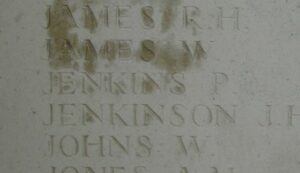
Daniel George John, Private, 352616, Manchester Regiment. Daniel was the son of David John and Sarah John (nee Ebsworth), of Cefncelfi Farm, Rhos, Cilybebyll. He enlisted at Pontardawe into the Manchester Regiment, and was posted to France with the 2nd/9th Battalion, Manchester Regiment, which was attached to 198 Brigade, 66th (2nd East Lancashire) Division. The division was originally formed for home service but embarked for France in February 1917, and concentrated by 16 March 1917 and moved to the Flanders Coast. At the end of September 1917, the division moved to Ypres, and on 3 October began its moved towards the front line below Passchendaele Ridge, relieving the Australians two days later, and began preparations to launch an assault on the morning of 9 October. The attacking troops left their trenches at 05.30 on 9 October 1917, launching the Battle of Poelcapelle. Daniel was killed in action at some time during the attack that day. The 19-year-old has no known grave and is commemorated on panel 120-124/ 162-163A on the Tyne Cot Memorial, Belgium.
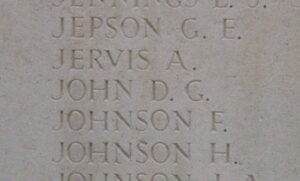
John Daniel John, Private, 20878, Royal Welsh Fusiliers. John was the son of Daniel and Mary John, of Primrose Cottages, Rhos Cilybebyll. He enlisted at Neath into the 14th Battalion, Royal Welsh Fusiliers, which was attached to 113 Brigade, 38th (Welsh) Division. He embarked for France with the division on 2 December 1915, and saw action during the divisions period of trench initiation in Flanders and also in its famed assault on Mametz Wood in July 1916. John was wounded at some time, and returned home for treatment, before being re-posted to the 1st/6th Battalion, Royal Welsh Fusiliers (Caernavon & Anglesey), which was in Egypt attached to the 53rd (Welsh) Division. The Allies had advanced through the Sinai Desert into Palestine early in 1917 and on 26 March 1917 suffered a defeat at the First Battle of Gaza. Between 17 and 19 April another offensive was launched, the Second Battle of Gaza, which again resulted in defeat mainly through poor leadership. After a change in command, when General Edmund Allenby replaced Sir Archibald Murray in command of the Egyptian Expeditionary Force, the EEF attacked again on 31 October 1917, in the Third Battle of Gaza, and this time successfully broke the Turkish lines, capturing Gaza and beginning the advance on Jerusalem. John was wounded at some time during the battle, probably during the advance on Gaza, and died of his wounds on 7 November 1917, aged 20. He is buried in grave B.5. in Beersheba War Cemetery, Israel. He is also reportedly commemorated on a memorial plaque within Ebenezer Chapel, at Rhos.
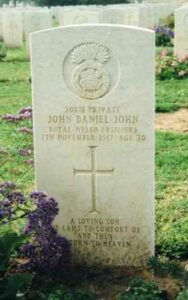
David Jones, Private, 4614, Pembroke Yeomanry. David was the fifth of seventeen children of David and Ruth Jones, of Alltwen Hill, Pontardawe. He worked as a butcher for his father before moving to Leominster, and married Margaret Ellen Parry on 7 March 1910. David enlisted at Carmarthen into the 2nd/1st Battalion, Pembroke Yeomanry, and was billeted in the town. David became ill and died of pneumonia at Carmarthen Infirmary on 25 January 1915, aged 32, becoming one of the first members of the regiment to lose their lives during the war. He was brought home to Pontardawe for burial in Alltwen Welsh Congregational Chapelyard. His brother John was killed in France on 24 April 1917, and another brother, Elias Jones, died of wounds on 19 August 1918.
Elias Jones, Private, 116737, Royal Army Medical Corps. Elias was the eighth of seventeen children of David and Ruth Jones, of Alltwen Hill, Pontardawe. He married Amy Jelfs in 1908 and the couple lived with her sister at 71, Herbert Street, Pontardawe. George worked in her butchers shop at Herbert Street prior to enlisting at Swansea into the Royal Army Medical Corps. Elias was posted to the 53rd Field Ambulance, Royal Army Medical Corps in France. The unit was attached to the 17th (Northern) Division, which had taken part in heavy fighting on the Somme in 1916, and at Passchendaele the following year, and got caught up in the German spring offensive, which was launched on 21 March 1918. After a period out of the line to rest and rebuild, the Division moved to the southernmost sector of the Somme area. Elias was gassed near Villers-Bretonneux and died as a result of his wounds at No 3 General Hospital, Le Treport, on 19 August 1918, aged 28. Elias was buried with full military honours in grave VII.B.6B. in Mont Huon Military Cemetery, Le Treport, France.
George Jones, Leading Seaman, Wales Z/3335, Royal Naval Volunteer Reserve. George was born on 23 September 1882, the son of Stephen and Mary Jones, of 11, Woodland Road, Pontardawe. He worked as a shearer prior to enlisting into the Royal Naval Volunteer Reserve and was posted aboard the steamer SS Artist. On 27 January 1917 Artist was steaming from Newport, Monmouth, for Alexandria with a cargo of coal, when she was torpedoed and sunk by the German submarine U-55. George was 34 years old when he died during the sinking that day, and is commemorated on panel 24 of the Plymouth Naval Memorial, Devon.
Gwilym Jones, Private, 30084, South Wales Borderers. Gwilym was the son of William and Mary Jones, of Swan House, Alltwen, Pontardawe. He worked as a behinder in the tinworks prior to enlisting at Pontardawe into the South Wales Borderers. Gwilym was posted to France, probably at some time in 1916, joining the 2nd Battalion, South Wales Borderers, which was attached to 87 Brigade, 29th Division and had suffered terrible casualties assaulting Y-Ravine on 1 July 1916. The division moved out of the battle area afterwards to rebuild before returning to action during the latter phase of the Somme offensive. In the Spring of 1917 the division took part in the Battle of the Scarpe, which was part of the Arras Offensive, and then moved further north to Ypres, taking part in the Third Battle of Ypres, seing heavy fighting before moving to Cambrai. Here the division took part in the Battle of Cambrai, which was launched on 20 November 1917 and saw the Hindenburg Line breached by a combined assault of tanks supported by infantry. The success was short-lived, for the Germans launched a massive counter-attack on 30 November, and recaptured all the ground lost. The 29th Division was caught up in this counter-attack, which saw the divisional commander almost captured due to the swiftness of the German advance. The division saw terrible fighting over the coming days, in its attempt to stem the German advance, and by 1 December the 2nd SWB was holding the canal between Marcoing and Masnières, and after suffering heavy casualties was ordered to withdraw from the village of Marcoing, but got caught up in more fighting on the night of 2-3 December. Gwilym was killed in action during this withdrawal at some time on 3 December 1917. The 29-year-old has no known grave and is commemorated on panel 5 of the Cambrai Memorial, Louverval, France. The battalion was relieved the following day.
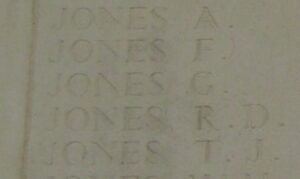
Jeffrey Richard Jones, Rifleman, R/15603, King’s Royal Rifle Corps. Jeffrey was born in Bucknall, Shropshire in 1895. By the time of the outbreak of war he was living at 20, George Street, Pontardawe, where he worked as a steel worker. He enlisted at Swansea into the King’s Royal Rifle Corps on 24 September 1915 and was sent along with a number of other recruits to their Depot at Winchester. Following his training he was sent to France on 25 February 1916, to join the 5th Battalion, King’s Royal Rifle Corps. Jeffrey was wounded by shrapnel during the opening assault of the Somme offensive on 1 July 1916, and was treated at the Western General Hospital at Manchester. After recovering, he was posted back to France on 19 November 1916, joining the 8th Battalion, King’s Royal Rifle Corps, which was attached to 41 Brigade, 14th (Light) Division, on the Somme. The division followed the German withdrawal to the Hindenburg Line in March 1917 and remained near Bertrancourt until moving out of the area and entraining for Ypres during the first week of July 1917. The division took up a section of the line near Wytschaete while the main Ypres offensive was launched just to their north, and then moved to the rear before taking over the line at Clapham Junction, east of Ypres. On 24 August 1917 the 8th KRRC was hit by a German counter-attack, but held the line despite heavy casualties. Among their dead was the 22 year old Jeffrey Jones. He has no known grave and is commemorated on the Tyne Cot Memorial, Belgium.
John Jones, Private, 46405, Welsh Regiment. John was the second of seventeen children of David and Ruth Jones, of Alltwen Hill, Pontardawe. He had trained as a butcher with his father prior to taking up a stall in Swansea Market, living in the town with his wife Edith and their three children. He enlisted into the Welsh Regiment at the end of 1915 and was posted to the 17th Battalion, Welsh Regiment (1st Glamorgan), which was attached to 119 Brigade, 40th (Bantam) Division. The division moved to France during the first week of June 1916, and moved to the front near Loos. Late in 1916 it moved south to the Somme, and fought at the Battle of the Ancre, remaining in the area over the winter. In March 1917 the Germans withdrew to their shortened line, called the Hindenburg Line, and the 40th Division was one of the Divisions that followed the withdrawal. By 18 April 1917 the division had moved forwards and the 17th Welsh was located around the village of Fins, moving forwards on 23 April in readiness for an assault from Fifteen Ravine towards La Vacquerie the following morning. At 04.15 on 24 April 1917 the British artillery barrage opened up and the division launched its assault. John was killed in action during this attack on 24 April 1917. The 38-year-old is buried in grave I.C.34. in Fifteen Ravine British Cemetery, Villers-Plouich, France, alongside a number of his comrades.
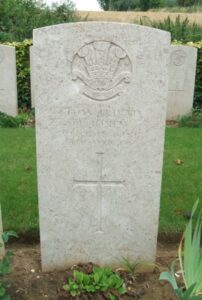
Oliver Jones, Able Seaman, Wales/Z/3333, Royal Naval Volunteer Reserve. Oliver was born on 4 July 1890, the son of Morgan and Sarah Jane Jones, of 42, Grove Road, Pontardawe. He enlisted into the Royal Naval Volunteer Reserve and was posted aboard the steamship SS Boscawen. On 21 August 1918 Boscawen was on route from Birkenhead for Barry and was steaming some 23 miles off Bardsey Island when she was torpedoed and sunk by the German submarine UB-92. Oliver was unfortunately the sole casualty of the sinking that day, while all his crew mates were rescued. The 28-year-old has no known grave and is commemorated on panel 29 of the Plymouth Naval Memorial, Devon.
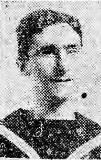
Philip Rees Jones, Private, 144815, Machine Gun Corps. Philip was born on 24 June 1898, the son of Daniel and Maria Jones, of Commercial Road, Rhydyfro, Pontardawe. He enlisted at Swansea into the South Wales Borderers, and upon moving to France was transferred to the 16th Battalion, Machine Gun Corps, which had been formed on 9 March 1918, and was attached to the 16th (Irish) Division. The division was by then stationed near St. Quentin, and was hit hard by the German Spring Offensive of 21 March 1918, taking part in the Battle of St Quentin, and then at the Battle of Rosieres, where it suffered terrible casualties. On 18 June 1918 the Division returned to England for refit, before returning to France on 1 August 1918 and fought through the Final Advance in Artois. Philip was killed in action a month before the Armistice, on 11 October 1918, aged 20. He is buried in grave M.5. in Sailly-Labourse Communal Cemetery Extension, France.

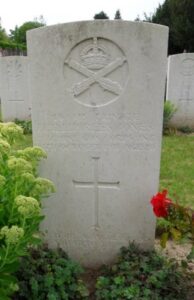
Thomas Jones, Private, 45970, Welsh Regiment. Thomas was the son of Evan and Ellen Jones, of Tynygraig, Cilybebyll, Pontardawe. He enlisted at Pontardawe into the Welsh Regiment, and was posted to the 18th Battalion, Welsh Regiment (2nd Glamorgan), which was attached to 119 Brigade, 40th (Bantam) Division. The Division moved to France during the first week of June 1916, and moved to the front near Loos. Late in 1916 it moved south to the Somme, and fought at the Battle of the Ancre, remaining in the area over the winter. In March 1917 the Germans withdrew to their shortened line, called the Hindenburg Line, and the 40th Division was one of the Divisions that followed the withdrawal. Later in the year the division took part in the Battle of Cambrai. On 23 November the 40th Division launched its assault on Bourlon Wood, sending 119 Brigade, with the support of tanks, into the wood, with 121 Brigade to its left. The 119th Brigade attacked on a two Battalion Front, with the 19th RWF on the right, the 12th SWB on the left, with the 17th Welsh in support and the 18th Welsh in reserve, around Graincourt. The fighting was terrible, so two companies of the 187th Welsh were sent in, and as a result of heavy casualties the 18th Welsh was also ordered into the wood. Thomas was killed during this heavy fighting in Bourlon Wood on 23 November 1917. The 21-year-old has no known grave and is commemorated on panel 7 of the Cambrai Memorial, Louverval, France.
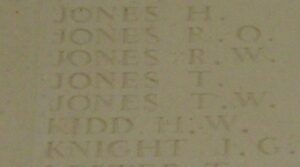
William Jones, Private, 93756, Royal Welsh Fusiliers. William was the son of David and Jane Jones, of Brook Cottage, Gellygron Road, Pontardawe. He worked as a press hand and lived at 23 Viola Bank, Stocksbridge, Sheffield prior to enlisting at Barrow into the South Wales Borderers on 11 December 1915. Due to being a skilled man, he was placed on the army reserve and was not called up into the 3rd Battalion, South Wales Borderers until 2 May 1918. He embarked for France on 2 September 1918 as a draft for the 2nd Battalion, South Wales Borderers, but upon reaching in infantry base depot was posted to the 2nd Battalion, Royal Welsh Fusiliers, which was by then attached to 115 Brigade, 38th (Welsh) Division and was advancing towards the Hindenburg Line and joined the battalion near Beaulencourt on 21 September, where it was refitting and resting. On 28 September the battalion moved forwards to hutments at Sorel-le-Grand, and on 4 October began advancing with the division to positions on the newly captured Hindenburg Line, near Bony and Lempire, where it received orders to attack Villers-Outreaux, a heavily defended, straggling village. The division attacked the village with the support of tanks, and was entirely successful, but a number of casualties had been suffered. William was among the men killed during the attack of 8 October 1918. The 23-year-old is buried in grave B.24. in Guizancourt Farm Cemetery, Gouy, France.
William Jones, Gunner, 99440, Royal Garrison Artillery. William was the son of Elias and Elizabeth Jones, of Coedcae Farm, Llannon, Llanelli. He lived at 8, Herbert Street, Pontardawe for many years prior to the war, where he was a partner in the business of Rees and Jones, Tobacconists and Hairdressers. He enlisted at Swansea into the Royal Garrison Artillery, and was placed on the army reserve until being called up on 13 June 1916. He was posted to France the following month and on 26 August 1916 was posted to the 221st Siege Battery, Royal Garrison Artillery. William was wounded while his battery was in action near Ypres, and died of his wounds at the 96th Field Ambulance on 27 July 1917, aged 38. He is buried in grave III.F.16. in Dickebusch New Military Cemetery Extension, Belgium.
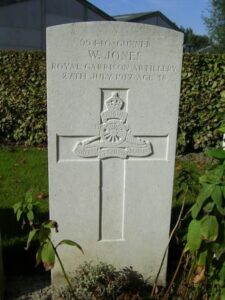
William James Jones, Private, 48187, Welsh Regiment. William was born at Glyncorrwg, the son of William and Marian Jones. By 1911 the family was living at 1 Avon Street, Cymmer, and soon after that William moved to Pontardawe for work. He married Elizabeth Jane Locke, of Danycoed, Ynysmeudw, Pontardawe in 1915 after he had enlisted at Swansea into the 8th Battalion, Welsh Regiment, but then transferred into the 11th Battalion, Welsh Regiment (Cardiff Pals), which was attached to 67 Brigade, 22nd Division. William landed in France on 2 October 1915, joining up with the battalion near Flesselles, where the division had assembled. Its stay in France was to be short-lived, as the division entrained for Marseilles and on 27 October 1915 began to embark for Salonika. The campaign in Salonika was difficult, as the Allies gained no real success in their campaign against the Bulgarians. The 22nd Division took part in the Retreat from Serbia during December 1915 and fought in several battles: Horseshoe Hill; Machukovo; and the three battles of Doiran. The last major action was during the Third Battle of Doiran, which was launched on 18 September 1918, and William was killed in action during the fighting that day. He was 24 years old and is buried in grave V.F.4. in Doiran Military Cemetery, Greece. An armistice with Bulgaria was signed on 30 September 1918.
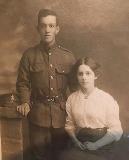
David Sidney Joseph, Private, 52848, Welsh Regiment. David was the son of David and Jane Joseph, of Brynamlwg House, Trebanos, Pontardawe. He enlisted at Cardiff into the Welsh Regiment, and was posted to the 8th Battalion, Welsh Regiment, which was in Mesopotamia attached to the 13th (Western) Division as its Pioneer battalion. The division had moved to Mesopotamia in 1916 following service at Gallipoli, and was among a number of units sent to attempt to lift the siege of General Townshend’s troops in the city of Kut. Following the surrender of the garrison of over 8,000 men on 29 April 1916, the survivors of the siege were marched to imprisonment at Aleppo, so the Allies instead started to advance on Baghdad. David died of sickness just prior to the resumption of the offensive, on 16 February 1918, aged 19. He is buried in grave XII.J.6. in Baghdad (North Gate) War Cemetery, Iraq.
Isaac Joseph, Private, 18254, South Wales Borderers. Isaac was born in Penclawdd, the son of Isaac and Phoebe Thomas. The family moved to Swansea Road, Trebanos prior to the war. Isaac married Elizabeth Banks, and the couple lived at 3 Old Post Office Place, Pontardawe. He enlisted at Cardiff into the 7th Battalion, South Wales Borderers, which formed as part of 67 Brigade, 22nd Division. The Division moved to France in early September 1915, and only spent a short period at the front before entraining for Marseilles, where it embarked for Salonika on 27 October 1915. The campaign in Salonika was difficult, as the Allies gained no real success in their campaign against the Bulgarians. The 22nd Division took part in the Retreat from Serbia during December 1915 and fought in several battles: Horseshoe Hill; Machukovo; and the three battles of Doiran. The last major action was during the Third Battle of Doiran, which was launched on 18 September 1918, and Isaac was killed in action during the fighting that day. He was 39 years old and is buried in grave III.C.7. in Doiran Military Cemetery, Greece. An armistice with Bulgaria was signed on 30 September 1918.
John Lacey, Private. This man cannot presently be identified.
Benjamin Lewis, Private, 23233, Royal Welsh Fusiliers. Benjamin was the son of Rees and Catherine Lewis, of Ynysmeudwy, Pontardawe. He worked as a tinworker prior to enlisting at Swansea into the 10th Battalion, Royal Welsh Fusiliers, which had been formed at Wrexham on 16 October 1914 as part of 76 Brigade, 25th Division. Benjamin landed at Boulogne with the battalion on 27 September 1915, and just over two weeks later the entire 76 Brigade was transferred to the 3rd Division. He saw his first major action with the battalion during the Actions of the Bluff, and at the St Eloi Craters, where the 10th RWF suffered heavily. The division was then moved south to the Somme, and fought there at the Battle of Albert, and the Battle of Bazentin, where it captured Longueval, and the 10th RWF gained the award of two VC’s. The division then took part in the Battle of Delville Wood, and the Battle of the Ancre, before settling into a bleak winter in France. In May 1917 the Division was at Arras, and fought at the First and Second Battles of the Scarpe, and at the Battle of Arleux and the Third Battle of the Scarpe, where it captured Roeux. Benjamin was killed whilst the battalion was holding the line at Monchy on 28 April 1917, when a shell burst near him. The 21-year-old has no known grave and is commemorated on bay 6 of the Arras Memorial, France. His commanding officer, Captain A. C, Daniel, wrote to his parents: ‘Benny was one of the very best in the sniping section, and was an example to everyone. I can truly assure you always that Benny, both in the trenches and out at rest, was a man of sterling character and a credit to all concerned. He had been with me through many months’ hard fighting, and his coolness and general behaviour on all occasions was the esteem and respect of all his comrades. He died as the result of a shell bursting near him, and his last words were: ‘I have not been hit.’ He suffered no pain.’
Brinley Richard Lewis, Major, Royal Field Artillery. Brinley was born in Pontardawe on 4 January 1891, the son of David and Margaret Lewis, of Tanyrallt. He was educated at Swansea Grammar School and at Cambridge University, where he gained three Blues. He played club rugby for Newport and gained the first of his two caps against Ireland in 1912. He had joined the Glamorgan Yeomanry in October 1914 and was commissioned into the Royal Field Artillery early in 1915, joining B Battery, 122nd Brigade, Royal Field Artillery, which was attached to the 38th (Welsh) Division, and landed in France with the battery on 25 December 1915. He served with the division during its period of trench initiation in Flanders, and then during its assault on Mametz Wood in July 1916, and moved with the division to positions along the canal bank north of Ypres, where he was promoted to Major. Brinley became the tenth former Welsh international rugby player to be killed during the war, when he was killed on 2 April 1917, aged 26. He is buried in plot 3, row C, grave 1 in Ferme Olivier Cemetery, Ieper, Belgium.
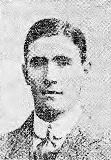
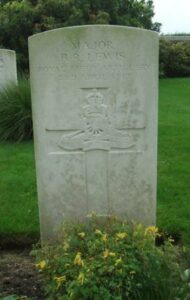
Howell Egbert Lewis, Ordinary Seaman, Wales Z/3381, Royal Naval Volunteer Reserve. Howell was the son of David Richard Lewis and Jane Lewis, of Swansea Road, Trebanos. He enlisted into the Royal Naval Volunteer Reserve and was posted aboard the steam driven oil tanker SS Narragansett. On 16 March 1917, Narragansett was returning from New York, with a cargo of oil, and was steaming in the Western Approaches when she was torpedoed and sunk with all hands by the German submarine U-44. Aboard Narragansett was a former member of Ernest Shackleton’s famous Antarctic team, Timothy McCarthy. Howell was 20 years old when he died that day, and is commemorated on panel 25 of the Plymouth Naval Memorial, Devon.
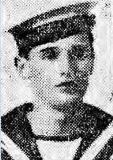
Jason Lewis, Private, 15436, South Wales Borderers. Jason was the son of Thomas and Elizabeth Lewis, of Abbeycwmhir, Radnorshire. He worked as a gardener for Doctor John Jones at Clydach prior to the war and in August 1914 attested into the South Wales Borderers. He was not called up straight away, so moved to 25 Cheltenham Road, Greaves, Lancaster after gaining another job, and married Annie Huck in 1915, just before being called up and joined the 7th Battalion, South Wales Borderers, which was attached to 67 Brigade, 22nd Division. The Division moved to France in early September 1915, and only spent a short period at the front before entraining for Marseilles, where it embarked for Salonika on 27 October 1915. The campaign in Salonika was difficult, as the Allies gained no real success in their campaign against the Bulgarians. The 22nd Division took part in the Retreat from Serbia during December 1915 and fought in several battles: Horseshoe Hill; Machukovo; and the three battles of Doiran. The last major action was during the Third Battle of Doiran, which was launched on 18 September 1918, and Jason was killed in action during the fighting that day. He was 37 years old and is commemorated on the Doiran Memorial, Greece. An armistice with Bulgaria was signed on 30 September 1918. Jason is commemorated on at least three other war memorials: at Abbeycwmhir, Rhayader, and Lancaster. His widow later lived at 16, Wellington Road, Bowerham, Lancaster.
Richard Lewis, Private, 44262, Royal Welsh Fusiliers. Richard was the son of David and Elizabeth Lewis, of 76 Brecon Road, Pontardawe. He enlisted at Swansea on 31 July 1916 into the Royal Welsh Fusiliers, and was posted to France, where he entrained for Marseilles, where he embarked for Salonika. He spent several weeks with the 2nd Entrenching Battalion before joining the 11th Battalion, Royal Welsh Fusiliers, which was attached to 67 Brigade, 22nd Division. The campaign in Salonika was difficult, as the Allies gained no real success in their campaign against the Bulgarians. The 22nd Division took part in the Retreat from Serbia during December 1915 and fought in several battles: Horseshoe Hill; Machukovo; and the three battles of Doiran. Richard was wounded on 24 April 1917, during the First Battle of Doiran, but soon re-joined the battalion. He was wounded again in February 1918 and was hospitalised for several months, re-joining the battalion in June, in time to take part in the last major action fought in Salonika, during the Third Battle of Doiran, which was launched on 18 September 1918. Richard was killed in action during the fighting that day. The 26-year-old is buried in grave B.344. in Karasouli Military Cemetery, Greece.
Robert John Mabbett, Private, 3512/53611, Welsh Regiment. Robert was the son of Robert and Mary Mabbett, of Swansea. Robert had enlisted at Swansea into the Welsh Regiment on 14 September 1897 and served with both the 1st Welsh and the 2nd Welsh over the coming years, seeing seven years’ service in India, before leaving the army on 13 September 1909, gaining work as a shunter at Gilbertson’s Works at Pontardawe. He married Elizabeth Ann Davies at St. Pauls Church, Landore on 5 October 1907 and the couple resided at White Hart Terrace, Trebanos. Robert re-joined the colours after the outbreak of war and was posted back to his old unit, the 2nd Battalion, Welsh Regiment, which was attached to 3 Brigade, 1st Division, joining the battalion on the Somme. The division had moved to the Somme from Loos in July 1916 and took part in heavy fighting during the Battle of Pozieres and also in the fighting for High Wood. It remained on the Somme until being taken out of the line in October for a month’s rest, before going back into the line at the end of the month, and the 2nd Welsh were placed on road building duties alongside the 6th Welsh. Robert was killed in action near Eaucourt L’Abbé on 28 November 1916. The 36-year-old has no known grave and is commemorated on pier and face 7A and 10A of the Thiepval Memorial, France.
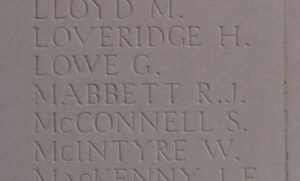
Henry Thomas Madge, Private, 45478, Northumberland Fusiliers. Henry was the son of Richard and Margaret Madge, of West End Villa, 77 High Street, Pontardawe. He worked as a tin-worker prior to enlisting at Sheffield into the Army Cyclist Corps, but subsequently transferred into the 14th Battalion, Northumberland Fusiliers, which was attached to 68 Brigade, 23rd Division and landed in France in August 1915. Henry joined the battalion on 10 November 1915, and took part in his first major action at the Battle of Albert, where the division captured Contalmaison. The division remained on the Somme throughout the remainder of 1916, capturing Le Sars, before being moved to positions near Ypres in October 1916. Henry was wounded on the Somme in 1916 and spent some time at home before re-joining his battalion at Ypres, where it took up positions near Larch Wood. His battalion was hit by a German raiding party on 13 May and in retaliation launched its own trench raid on the night of 16/17 May 1917. Henry was most likely one of several men wounded during the raid, and taken prisoner by the Germans. He died in German hands on 2 June 1917, aged 32. Henry has no known grave and is commemorated on bay 2-3 of the Arras Memorial, France.
Ernest Joseph Masterman, Corporal, GS/65787, Royal Fusiliers. Ernest was the son of George and Sarah Masterman, of Parkstone, Dorset. He married Amy Ann Golding in 1909 and the couple came to live at Graig Road, Alltwen, Pontardawe in 1914 after Ernest had gained work at Gilbertson’s Works. He enlisted into the 5th Dragoon Guards in August 1914, but deserted his regiment, returning to Pontardawe where he was arrested in February 1917. He was then posted to the 13th Battalion, Royal Fusiliers, which was attached to 111 Brigade, 37th Division. Ernest probably joined the battalion after it had moved from the Somme sector to Arras. The division took part in the First Battle of the Scarpe, where it captured Monchy le Preux. It then took part in the Second Battle of the Scarpe, and the Battle of Arleux before moving north to Ypres, where it took part in severe fighting during the Third Battle of Ypres. During March 1918 the Division was at the Somme, and saw heavy fighting following the German offensive, which was launched on 21 March 1918. By the beginning of August 1918, the division was north of Bucquoy, and the 13th Royal Fusiliers were near Pigeon Wood. On 8 August a combined Allied assault around Villers-Bretonneux broke the German lines, and probably as a result of this, on 14 August the Germans facing the 37th Division began to withdraw. The division carried out a series of attacks over the coming days, and reached Achiet-le-Petit by 23 August, while the general Allied advance had by now began all along the line. Ernest was wounded during this advance, and died of his wounds on 25 August 1918, aged 33. He is buried in grave IV.E.32. in Bagneux British Cemetery, Gezaincourt, France.
Richard Gunton Michael, Private, 32671, York And Lancaster Regiment. Richard was the son of Llewelyn and Mary Michael, of Dolcoed, Brecon Road, Pontardawe. He was a bank clerk before the war and had worked at Port Talbot, Ammanford and Gloucester prior to enlisting at Port Talbot into the Royal Field Artillery on 10 December 1915. He embarked for France on 26 April 1917 and landed at Boulogne the following day, and on 15 May was transferred to the 8th Battalion, York and Lancaster Regiment, which was attached to 70 Brigade, 8th Division. On the following month the brigade joined the 23rd Division, which was at Ypres. On 4 June 1917 the battalion moved into the front line near Mount Sorrel to begin a short tour of duty. Richard was killed in action here during a German counter-attack on 8 June 1917, aged 19. He has no known grave and is commemorated on panel 36/55 of the Ypres (Menin Gate) Memorial, Belgium.
David Morgan, Lance Corporal. David cannot presently be identified.
Thomas Morgan, Lance Corporal, 2730, Australian Infantry. Thomas had been born in New York, the son of Welsh parents, John and Elizabeth Morgan, who by 1891 had moved back to their native Wales, settling eventually at Thomas Street, Pontardawe. He married Hannah Thomas, of Maesgwyn, Dyfryn Road, Alltwen in 1903 and the couple had two children. Thomas worked as a bricklayer at Gilbertson’s Works in Pontardawe before emigrating to Australia prior to the war. He enlisted at Goulburn, NSW on 25 July 1915 into the 6th Reinforcements for the 18th Battalion, Australian Infantry and embarked on 2 November 1915 for Egypt. Upon arriving in Egypt he joined the Australian camp at Tel-el-Kebir and on 14 February 1916 was posted to the 3rd Battalion, Australian Infantry, which had returned to Egypt after service in Gallipoli. In March 1916, it sailed for France and the Western Front, attached to the 1st Australian Division, and familiarised itself in the Fromelles sector before being moved south to take part in the Somme offensive. The battalion’s first major action in France was at Pozieres in July 1916, where Thomas was wounded in the hand. He re-joined the battalion in time to take part in the Australian attempt to capture Mouquet Farm, where they suffered terrible casualties. Later the battalion moved to Ypres, before returning to the Somme for the winter. By 23 December 1916 the 3rd AIF was in the line near Gueudecourt, carrying out repairs to their trenches and working on deep dug-outs at Grass Lane. Thomas was killed in action here by German shell-fire on 24 December 1916, aged 35. He was originally buried at the junction of trenches called Fritz’s Folly and Fatigue Alley, in map reference 57c.S.E., but his grave was lost at some time afterwards, so he is now commemorated on the Villers-Bretonneux Memorial, France.
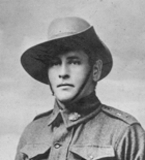
Charles Douglas Morrison, Private, 4013, Royal Welsh Fusiliers. Charles was the son of George William Morrison and Sarah Elizabeth Morrison. He was brought up in a home in Bristol before joining the army, and after completing his service joined the army reserve before moving to Pontardawe. He married Mary Elizabeth Evans, of 1, Court Lane, Pontardawe, in 1912. Charles re-joined his old battalion, the 1st Battalion, Royal Welsh Fusiliers soon after the outbreak of war and landed in France on 2 November 1914, joining the battalion at Bailleul soon afterwards and being posted to D Company. He saw his first major action with the battalion during the Battle of Neuve Chapelle in March 1915 and in May fought at the Battle of Aubers Ridge, and at Festubert. The 7th Division took part in the Battle of Loos in September 1915, taking part in the initial assault north of the Vermelles-Hulluch road, facing the Quarries, and got badly caught up in British gas and German machine-gun and artillery fire. During the first weeks of December 1915 the division moved to the Somme sector, and trained for several weeks in the back area around Montagne before moving to the front at the end of January 1916 and taking up the line around Fricourt. The battalion moved into the front line on 14 March 1916 for a short spell in the trenches, and it was during this period that Charles was mortally wounded. He died of his wounds soon afterwards, on 16 March 1916, aged 29, and is buried in grave D.1. in Point 110 New Military Cemetery, Fricourt, France.
Arthur James Moseley, Private, 49297, Royal Army Medical Corps. Arthur was the son of James and Louise Moseley, of Pontypool. He was a tinworker prior to the war and lodged at 2 Tawe Terrace, Pontardawe, prior to marrying Maria Maddock at Pontardawe early in 1915. Arthur enlisted at Cardiff into the Royal Army Medical Corps and was posted to Millbank, in London, to the 35th Company, Royal Army Medical Corps. He was posted to the 39th Field Ambulance, which was attached to the 13th (Western) Division, which landed at Cape Helles, Gallipoli from 6 July 1915, relieving the 29th Division. The division left and returned to Mudros at the end of the month, and was landed at ANZAC Cove from 3 August 1915, to fight alongside the ANZAC Corps. Soon afterwards the Division was transferred from ANZAC to Suvla Bay and it was here that Arthur was wounded. He died of his wounds aboard the Hospital Ship Assaye on 23 September 1915, aged 20. Arthur was buried at sea, so is commemorated on panel 199-200 of the Helles Memorial, Gallipoli.
William James Newlands, Able Seaman, Z/2219, Royal Naval Volunteer Reserve. William was born on 10 May 1897, the son of James and Mary Newlands, of Rhydyfro, Pontardawe. William worked as a tinworker prior to enlisting into the Royal Naval Volunteer Reserve on 25 October 1915, and was posted to France on 18 September 1916, joining Hood Battalion, Royal Naval Division. The battalion was attached to 189 Brigade, 63rd (Royal Naval) Division, and saw fighting in the Ancre Valley on the Somme over the winter, before moving to the Arras sector in the spring of 1917. William was killed in action here during the Battle of Arras, on 23 April 1917, aged 19. He has no known grave, and is commemorated on bay 1 of the Arras Memorial, France. The family later moved to 44 High Street, Cwmgorse.
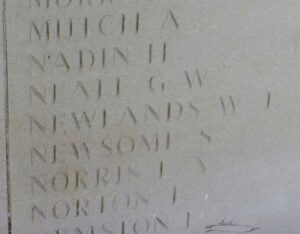
George Offer, Private, 51210, Machine Gun Corps. George was the son of George and Emma Offer, of Romsey, Hampshire. By 1911 he was living at Cilmaengwyn Woods, Ynysmeudwy and worked as a quarryman. He enlisted at Cardiff into the 10th Hussars, and was posted to France, where he transferred into the 8th Squadron, Machine Gun Corps (Cavalry), which had formed on 29 February 1916, becoming attached to the 8th Cavalry Brigade, 3rd Cavalry Division. George was killed in action that year, during the Somme offensive, on 26 August 1916, aged 32. He has no known grave and is commemorated on pier and face 5C of the Thiepval Memorial, France.
Albert Edward Painter, Private, 13977, Welsh Regiment. Albert was the son of Edward Charles Painter and Eliza Florence Painter, of 63, Carlton Road, Bath. He lived and worked at Pontardawe prior to the war and enlisted there at the end of August 1914 into the Welsh Regiment. Albert was posted to the 9th Battalion, Welsh Regiment, which was attached to 58 Brigade, 19th (Western) Division, and landed in France with the battalion on 18 July 1915. He survived the Divisions abortive assault on the opening day of the Battle of Loos on 25 September 1915. The following year the Division moved to the Somme, where it took part in the second wave of the attack on Ovillers-La Boisselle on 1 July, capturing the village at heavy cost. It then fought through the Somme Battles of Pozieres and the Ancre in 1916. In 1917 the Division moved North to Ypres, taking part in the Battle of Messines from 7 to 14 June. The division held onto its positions in the sector over the coming weeks, and on 18 July the 9th Welsh had been relieved from positions at Onraet Wood before moving to billets in Locre. Soon afterwards the Germans attacked the positions vacated by the 9th Welsh, so on the following morning D Company, 9th Welsh was ordered back to help retake the lost position. Albert was among twenty casualties suffered by the battalion during the ensuing fighting on 19 July 1917. The 20-year-old has no known grave and is commemorated on panel 37 of the Ypres (Menin Gate) Memorial, Belgium.
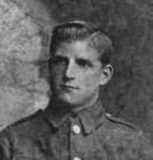
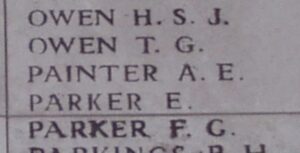
Arthur Joseph Parker, Sergeant, 5586, Somerset Light Infantry. Arthur was the son of Joseph and Jane Parker, of 2, Balmoral Road, Bristol. He had served with the Somerset Light Infantry during the Boer War of 1899-1901 and after being discharged from the army married Martha Jacobs at Bristol in 1907. By 1911 the family was living in Glynteg Cottages, Gellygron Road, Pontardawe, and Arthur was working as a chemical labourer, as well as acting scoutmaster. He re-enlisted into the 1st Battalion, Somerset Light Infantry soon after the outbreak of war, and was posted to France in 1916 to the 7th Battalion, Somerset Light Infantry, which was attached to 61 Brigade, 20th (Light) Division. The division had moved to the Somme in the spring of 1916 and took part in the Battle of Delville Wood, and then in the ensuing Battle of Guillemont. The next major action for the division was during the Battle of Flers-Courcelette, and it was during an action to the north of Ginchy that Arthur was killed in action on 16 September 1916, aged 33. He is buried in grave XII.K.5. in Guards’ Cemetery, Lesboeufs, France.
David Samuel Phillips, Sapper, 146068, Royal Engineers. David was the son of Thomas and Elizabeth Phillips, of Llwynhyfred Farm, Lower Cwmtwrch. He married Elizabeth Ann Hodges at Pontardawe on 1 August 1910 and the couple lived at 4, Dynevor Terrace, Pontardawe. David had served in the 4th Welsh prior to the war. He re-enlisted at Pontardawe on 16 October 1914 into the Brecknock Battalion, South Wales Borderers. He was discharged upon re-enlisting into the Tunnelling Company, Royal Engineers on 27 January 1916 and on 12 February 1916 embarked for France with the 253rd Tunnelling Company, Royal Engineers, which headed to Sailly-Labourse before beginning work in the front-line areas of the old Loos battlefield, north of the Vermelles-Hulluch road. In mid-1917, the Company was engaged in constructing light railways to the battery positions of Fifth Army, preparatory to the 31 July 1917 attack at Ypres. On 19 June 1917 David was admitted to No 58 Casualty Clearing Station after suffering a gunshot wound to his thigh, and was evacuated home to the City of London Military Hospital, Clapton, where he died of his wounds on 23 July 1917, aged 32. His body was brought home for burial in St. Mary’s Churchyard, Ynysmeudwy. His widow, Elizabeth, had lost her brother Benjamin Hodge during the war, and he is also commemorated on the Pontardawe Memorial.
Ernest George Poll, Rifleman, 781, Rifle Brigade. Ernest was born on 12 February 1886, the son of William and Susannah Poll, of Great Yarmouth. He enlisted into the Rifle Brigade on 1 April 1902 and served with the regiment until seeking his discharge, and moved to west Wales to live with his brother Henry James Poll at 3, Mill Row, Alltwen. Ernest worked at Pontardawe prior to the war when he re-enlisted into his old regiment, and landed at St. Nazaire, France with the 3rd Battalion, Rifle Brigade on 22 September 1914. The battalion was attached to 17 Brigade, 6th Division which had been sent out to reinforce the hard-pressed BEF on the Aisne, before the whole army was moved north into Flanders. Here they took part in the Action of Hooge during June 1915. On 14 October 1915 the battalion transferred with 17 Brigade to the 24th Division and was posted to the Somme sector in 1916, where it took part in the fighting at Delville Wood and Guillemont. On 1 August 1916 the battalion marched from the Bois Des Tailles to sandpits and craters north of Carnoy, where it spent two weeks, coming under intermittent shellfire and suffering a number of casualties. On 17 August the battalion moved forwards towards Guillemont in order to take part in an assault on the village and on the following day, 18 August 1916 made its attack, capturing a number of trenches. Ernest was wounded at some time during this period, and died of his wounds at Corbie on 20 August 1916, aged 29. He is buried in plot II, row A, grave 10 in La Neuville British Cemetery, Corbie, France.
George Morgan Powell, Private, 235043, Royal Welsh Fusiliers. George was the son of Rachel Powell, of Balaclava Road, Glais. He married Ada M Thomas in 1912 and the couple lived at Primrose Cottage, Ynysmeudwy, Pontardawe. George enlisted at Pontardawe into the South Wales Borderers soon after the outbreak of war, and was later posted to France, joining the 10th Battalion, Royal Welsh Fusiliers, which was attached to 76 Brigade, 25th Division. The battalion landed at Boulogne on 27 September 1915, and the following month transferred with 76 Brigade to the 3rd Division. The division saw heavy fighting at the Bluff and the St. Eloi Craters early in 1916 before moving south to the Somme, and played a particularly important role in the heavy fighting in Delville Wood, where the 10th RWF gained the award of two Victoria Crosses. After a bleak winter, the division moved to the Arras sector, to take part in a fresh offensive there, and fought in the First and Second Battles of the Scarpe, and at the Battle of Arleux and the Third Battle of the Scarpe. George was killed in action while the 10th RWF was in the line at Monchy, just prior to the final attacks on Roeux. The 27-year-old has no known grave and is commemorated on bay 6 of the Arras Memorial, France.
Rees, Private. This man cannot presently be identified.
George William Sayce, Lance Corporal, 26947, King’s Shropshire Light Infantry. George was the son of George and Elizabeth Sayce, of Knighton, Radnorshire. He worked as a weaver before moving to Rhydyfro, Pontardawe prior to the war. He returned to Knighton to enlist into the King’s Shropshire Light Infantry soon after the outbreak of war and was posted to France with the 7th Battalion, King’s Shropshire Light Infantry, which landed at Boulogne on 28 September 1915 attached to 76 Brigade, 25th Division. On the following month the battalion transferred along with the brigade to the 3rd Division and early in 1916 fought at the Actions of the Bluff, and at the St Eloi Craters. The division was then moved south to the Somme, and fought there at the Battle of Albert, and the Battle of Bazentin, where they captured Longueval. It then took part in the Battle of Delville Wood, and the Battle of the Ancre, before settling into another bleak winter in France. In 1917 the Division was at Arras, and fought at the First and Second Battles of the Scarpe, and at the Battle of Arleux and the Third Battle of the Scarpe, where it captured Roeux. The division was then moved northwards to Ypres, where it fought in the Battle of the Menin Road and the Battle of Polygon Wood. In November the Division moved south again, and fought at the Battle of Cambrai. It was still in the Cambrai sector during March 1918 when the German Spring Offensive swept through the British lines, and took part in the heavy rear-guard fighting which ensued. The 7th KSLI took part in heavy fighting on the first morning of the attack on 21 March and over the coming days continually beat off German attacks on its positions before being withdrawn to a secondary defensive position west of Henin. George was killed during a heavy German attack on the morning of 28 March 1918, which broke through the battalions’ lines and decimated the battalion. The 24-year-old has no known grave and is commemorated on Bay 7 of the Arras Memorial, France.
Garfield Stanley Sainsbury Silcox, Private, 425314, Canadian Infantry. Garfield was born at Saundersfoot on 8 November 1888, the son of James Henry and Sarah Jane Silcox. The family later lived at Pembroke Dock, before moving to Skeena, Park View, Swansea. Garfield was the brother of Reginald Silcox, the manager of the Pontardawe Gas Works. Garfield emigrated to Canada, where he worked for the Grand Trunk Pacific Railway. He enlisted at Winnipeg on 1 September 1915 into the 45th Battalion, Canadian Infantry, and arrived in England on 25 March 1916. Garfield then landed in France on 25 May 1915, where he was posted to the 2nd Canadian Mounted Rifles, which was attached to the 8th Brigade, 3rd Canadian Division. Garfield joined his new unit in time to take part in the Battle of Mount Sorrel. The Canadians then moved to the Somme, and took part in the Battle of Flers-Courcelette, and the Battle of Thiepval during September 1916. On 1 October 1916 the Battle of Le Transloy was launched, and Garfield was killed here on 9 October 1916, aged 29. He is commemorated on the Vimy Memorial, France.
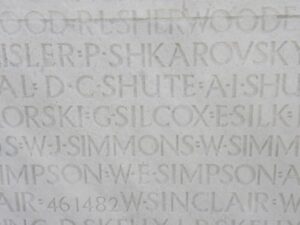
Albert James Smith, Private, 39835, East Surrey Regiment. Albert was the illegitimate son of Emily Smith, and was raised by her parents, Thomas and Ann Smith, at Chearsley, Buckinghamshire. In 1904 Emily married George Hearn, a railway worker from Swansea, and moved to 14, Tawe Terrace, Pontardawe, where she gave birth to two more children. Albert enlisted at Northampton into the Royal West Surrey Regiment, and was posted to the 1st/21st Battalion, London Regiment (Surrey Rifles), which was attached to 142 Brigade, 47th (2nd London) Division. The division had been in France since March 1915, and had seen action at Aubers Ridge and Loos, before taking part in the Somme offensive the following year. Early in 1917 the Division moved north to Belgium, and took part in the Battle of Messines, and then in November 1917 fought at the Battle of Cambrai. In March 1918 the Division was situated near St. Quentin, and faced the German Spring Offensive here on 21 March, fighting at the Battle of St Quentin, and in the rear-guard action at the First Battle of Bapaume. In August 1918 the British attacked on the Somme, and the Division fought in the Battle of Albert, and then at the Battle of Bapaume. Albert was killed during heavy fighting around Bapaume on 1 September 1918. The 19-year-old has no known grave and is commemorated on panel 6 of the Vis-en-Artois Memorial, Haucourt, France.
Walter Clarence Smith, Private, 20896, York and Lancaster Regiment. Walter was the son of John and Charlotte Smith, of 18, Albert Villas, Oakengates, Salop. He came to live at Pontardawe after gaining work in the galvanising department at Gilbertson’s Works prior to the war. He attempted to enlist into the Royal Marines, but was rejected, so travelled back to Wellington to enlist into the Hussars on 1 September 1914. He joined the Reserve Cavalry Regiment in Dublin for a short time before being transferred to the 6th Battalion, York and Lancaster Regiment on 8 June 1915. The battalion was at Witley attached to 32 Brigade, 11th (Northern) Division and on 3 July 1915 sailed from Liverpool for Gallipoli aboard HMT Aquitania, landing at Suvla Bay 6 August 1915. The division took part in some heavy fighting at Suvla over the coming days and suffered heavy casualties. On 16 September 1916 the battalion was in the trenches at Jefferson Pool, carrying out trench repairs, when Walter was killed by a sniper. The 20-year-old has no known grave and is commemorated on panel 171-3 of the Helles Memorial, Gallipoli.
Arthur Stock, Private, 9819, Somerset Light Infantry. Arthur was the son of Robin and Mary Eliza Stock, of Temple Cloud, Bristol. He lodged with Mr and Mrs Perry at Old Road, Ynysmeudwy prior to the war and worked at the Bryn Tinplate Works. He enlisted at Taunton alongside two of his cousins into the 6th Battalion, Somerset Light Infantry, which was attached to 43 Brigade, 14th (Light) Division, and landed in France with the battalion on 21 May 1915. The Division was to see its first action during the Action of Hooge, where the Division was the first to be attacked by the German use of flamethrowers. Arthur was wounded during the terrible fighting which ensued and spent some time in hospital before re-joining his battalion. The battalion was back in a support line in front of Railway Wood by 25 September, watching a heavy artillery barrage come down on the German lines from Railway Wood to Sanctuary Wood, during the opening of the Second Attack on Bellewaarde, and in the morning moved forwards to reinforce the front line. The attack was a diversion to the main offensive to the south, at Loos. On the following day, 26 September 1915, the battalion was kept busy repairing their trench, and at sometime during the day Arthur was killed in action. The 22-year-old has no known grave, and is commemorated on panel 85-7 of the Loos Memorial, France. This is really the wrong memorial, as he should be commemorated on the Menin Gate.

Harry Thomas, Private, 11166, Royal Welsh Fusiliers. Harry was the son of Thomas and Gwenllian Thomas, of 4, Curtis Row, Ynysmeudwy. He worked as a behinder prior to enlisting at Swansea into the 1st Battalion, Royal Welsh Fusiliers, which embarked for Zeebrugge as part of 22 Brigade, 7th Division, landing in the port on 7 October 1914. The Germans had already begun attacking the port, so the 7th Division was moved south to assist in the defence of the city of Ypres, becoming the first British Division to hold the city. They fought during the First Battle of Ypres, and helped stop the German advance through Belgium. The division then slipped to the right of the British Line, and by 29 October the division had taken over positions around Givenchy. On the following day the 1st RWF was in the trenches near a position called the Duck’s Bill, due to the shape of the salient it formed, when a massive explosion blew a crater in front of their positions, which was seized by the Germans who consolidated it into their own front. The explosion was coupled with a heavy artillery bombardment, and it was during this bombardment that Harry was killed in action, on 30 October 1914. The 22-year-old has no known grave and is commemorated on panel 22 of the Ypres (Menin Gate) Memorial, Belgium.
Robert Pendrill Thomas, Third Engineer, Mercantile Marine. Robert was the son of Robert and Hannah Thomas, of 4, Thomas Street, Pontardawe. Robert served as an engineer with the Mercantile Marine and was serving as Third Engineer aboard the London registered steamship SS Bayronto. On 30 July 1918 Bayronto was steaming past the Isle of Wight, when she was attacked and torpedoed by the German submarine UB-88. Robert and one other crew-member were killed in the explosion, but Bayronto survived, limping home for repairs. Officially Robert, who was 30 years old, has no known grave and is commemorated on the Tower Hill Memorial, London, but two obituaries were published at the time in local newspapers which stated that his body was brought home for burial in St. Samlet’s Churchyard, Llansamlet at 5.00 pm on 12 August 1918. I have located copies of the burial register proving this and have recently (26 February 1918) forwarded the evidence to the CWGC. Bayronto later foundered in heavy seas during a Hurricane on 13 September 1919.
William Thomas, Sergeant, 29525, Royal Welsh Fusiliers. William was the son of John and Mary Thomas, of The Hill, Alltwen, Pontardawe. He worked for Lewis and Co, hosiers, at Rutland Street, Swansea prior to enlisting at Swansea into the Royal Welsh Fusiliers, and became a sergeant-instructor with the 38th (Welsh) Division at Rhyl. Early in 1918 William was posted to France, joining the 9th Battalion, Royal Welsh Fusiliers, which was attached to 58 Brigade, 19th (Western) Division. He probably joined the battalion following its ordeals on the Somme, during the German offensive which was launched on 21 March, and saw the 19th Division suffer terrible losses. It was transferred north to the Ploegsteert sector to rest and rebuild, but was hit by a second offensive on 9 April and saw heavy fighting again before being transferred to a more peaceful sector on the Aisne. Unfortunately, this was the location chosen by the Germans to launch their third, and last, offensive of the war, and they hit the French and British lines hard on 27 May, causing panic before the line stabilised and their offensive was closed down. The now unrecognisable 19th Division was then moved north to rebuild again, before taking part in the great 100 days offensive which won the war. William was killed in action when the battalion was bombarded with gas shells whilst holding Curzon Trench, near Essars, on 15 September 1918, aged 23. He is buried in grave V.E.3. in St. Vaast Post Military Cemetery, Richebourg L’Avoue, France.
William John Thomas, MM, Lance Corporal, 54058, Royal Welsh Fusiliers. William was born at Pontardawe in about 1896, the youngest son of George and Sarah Thomas, of 6, Compass Row. He enlisted into the Royal Welsh Fusiliers in 1916 and probably arrived in France by October that year. He was wounded on the Somme soon after arriving in France, after being struck by shrapnel fragments in the arm, and was hospitalised for a while at Brighton, before returning to France at some time in 1917. He was posted to the 16th Battalion, Royal Welsh Fusiliers, which was attached to 113 Brigade, 38th (Welsh) Division and had taken part in the famous capture of the Pilckem Ridge on 31 July 1917. By March 1918 the 38th (Welsh) Division was in the line east of Armentieres, guarding the town following reports of a possible forthcoming German offensive. Thomas appears to have been selected to be part of a large raiding party which began moving up towards the divisional front line on 15 March 1918 and at just after 22.00 that night advanced under a trench mortar barrage across No Man’s Land before entering the German trenches at a point called Incandescent Trench. The raid was supported by feint attacks against Central and Inane Trenches, which included the hoisting up of dummies over the parapet in order to draw German fire. A fierce fight ensued, which resulted in the killing of over fifty Germans and the capture of fifteen prisoners and two machine-guns, before the raiding party crept back to their own lines. Due to the success of the feint attack which caused confusion among the enemy, the retaliatory German fire fell down on their own trenches. The raid had been a success but came at a cost to the 16th Royal Welsh Fusiliers. One officer and twelve other ranks had been killed, while four men were missing (later found to have been killed) and one officer and thirty three other ranks had been wounded. William was among eight men recommended for gallantry awards due to their conduct during the raid and on 24 March was decorated with the ribbon of the Military Medal. His award was mentioned in the battalion war diary for the day. Following the launching of the German spring offensive on the Somme on 21 March 1918, the 38th (Welsh) Division was moved south to hold the line at Bouzincourt Ridge, just to the north of the town of Albert. On 22 April 1918 113 Brigade took part in an attack to clear the Germans off the ridge and force them to withdraw across the Ancre valley. William was killed in action during the costly attack that day. He was 21 years old and is buried in grave I.A.24. in Bouzincourt Ridge Cemetery, Albert, France. He had been engaged to be married, but sadly this was never to be. His fiancée never forgot him and her two children have recently visited his grave.
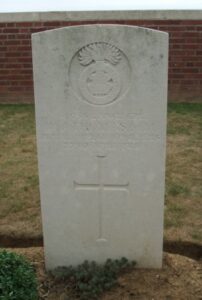
Edward Joseph Bernard Torney, Private, 12067, South Wales Borderers. Edward was the son of Edward Joseph Torney and Emily Torney, of 111, Gibbon Road, Kingston on Thames. He had served for two years with the East Surrey Regiment prior to the war. He married Mary Jane Tombs in 1912 after leaving the colours and the couple moved to Rose Cottage, Trebanos after Edward had found work at Gilbertson’s Steel Works. He re-enlisted at Brecon into the Brecknockshire Battalion, South Wales Borderers on 15 January 1915 and was later posted to France, probably in the late summer of 1916, joining the 2nd Battalion, South Wales Borderers, which had been decimated during the assault of the 29th Division on Y-Ravine on 1 July 1916. After taking part in the latter stages of the Somme offensive the division moved to the Arras sector and in the Spring of 1917 fought at the Battle of the Scarpe, which was part of the Arras Offensive, before moving further north to Ypres. Here it fought at the Battle of Langemarck, and played a part in the later attacks on the ridge before moving to Cambrai. Here it fought at the Battle of Cambrai in November and December 1917 before moving back to Flanders early in 1918. The German Spring Offensive hit the British on the Somme on 21 March 1918, and hit in Flanders just weeks later, and the 29th Division got caught up in heavy fighting. Edward was wounded and taken prisoner at this time and died of his wounds in a prison camp in Germany on 20 May 1918, aged 32. He is buried in grave I.E.5. in Berlin South-Western Cemetery, Germany.
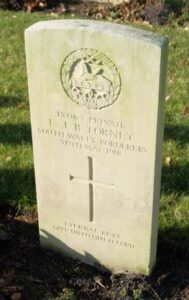
A. West, Private. This man cannot presently be identified, but he appears to have died early in 1917. Two separate newspaper reports name him as B. J. West, of the 5th Devon Regiment, but no man of that name can be traced. A man named J.A. West who worked at the Mond Nickel Works enlisted into the Devonshire Regiment in October 1914 and is commemorated on their war memorial.
Albert Montgomery Williams, Private, 44975, South Wales Borderers. Albert was the son of Joseph and Elizabeth Ann Williams, of Pontardawe. He married Rachel Augusta Jeremiah in 1909 and the couple resided at 46 James Street, Pontardawe. Albert worked as a galvaniser prior to enlisting at Brecon into the 3rd Battalion, South Wales Borderers and was later posted to Salonika to join the 7th Battalion, South Wales Borderers, which was attached to 67 Brigade, 22nd Division and had been in Salonika since November 1915, fighting against the Bulgarians. The division fought at the Battle for Horseshoe Hill from 10 to 18 August 1916, then between 13 to 14 September 1916 at the battle of Machukovo. Between 24-25 April and 8-9 May 1917, the Division fought at the battle of Doiran, and then on 18 September 1918 at the Second Battle of Doiran. The Allies never managed to break through the Bulgarian Lines, but with the war swaying in favour of the Allies, an armistice with Bulgaria was signed on 30 September 1918. Albert had been wounded during the final stages of the war and he died of his wounds at the 28th General Hospital, Salonika on 10 October 1918, aged 32. He is buried in grave 605 in Mikra British Cemetery, Kalamaria, Greece.
Arthur Williams, Private, 59761, Royal Welsh Fusiliers. Arthur was the son William and Ann Williams, of Maes Gwyn, Trebanos. He was a tin-worker prior to enlisting at Swansea in 1916 into the Royal Welsh Fusiliers, and was posted to France to join the 17th Battalion, Royal Welsh Fusiliers, which was attached to 115 Brigade, 38th (Welsh) Division. He joined the battalion following its ordeals at Mametz Wood in July 1916, after it had been transferred to the Canal Bank positions, north of Ypres. The division launched its assault on the Pilckem Ridge from here on 31 July 1917, and saw further fighting at Langemarck before being moved to positions around Armentieres for the winter. Following the launching of the German Spring offensive on the Somme on 21 March 1918 the division was rushed south, taking up the line north of Albert along Bouzincourt Ridge. The battalion reached the Somme sector on 1 April and on the following day moved into billets at Hedauville where it began preparing for the move towards the front line. On 7 April the battalion marched to billets in Herrissart. Arthur was one of four men of the battalion to be wounded on 11 April 1918. The battalion was still behind the lines, so presumably German shellfire was to blame for these casualties. He died of his wounds on the following day, 12 April 1918, aged 21, and is buried in grave IV.B.3. in Vignacourt British Cemetery, France.
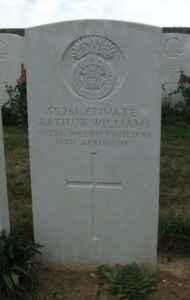
Arthur Harold Williams, Engine Room Artificer 4th Class, M/19636, Royal Navy. Arthur was born at Lydbrook, Gloucester on 28 December 1893, the son of John and Sarah Jane Williams. The family later resided at Green Villa, Banwen. Arthur worked as a tinplater prior to enlisting into the Royal Navy on 14 March 1916 and after training at HMS Vivid was posted to HMS Colleen at Queenstown, Cork. The Queenstown Command covered the waters off southern Ireland, and had a fleet of motor launches under its command. Arthur was posted to the motor sloop HMS Aubretia. Arthur took ill while based at Queenstown, and died of sarcoma at Haulbowline Naval Hospital on 13 September 1917, aged 24. He is buried in grave C.25.68. in Cobh Old Church Cemetery, Ireland.
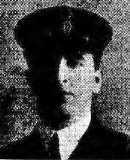
John Benjamin Williams, Leading Seaman, Wales Z/3030, Royal Naval Volunteer Reserve. John was born on 13 March 1896, the son of David Robert Williams, of Cryd-yr-Awel, Belgrave Road, Loughor. His father was the tinhouse superintendent at the Mardy Works, Gorseinon, whilst his grand-father John Williams, was a watchmaker and jeweller at Pontardawe. John enlisted into the Royal Naval Volunteer Reserve, and was posted aboard the cargo steamer SS St Olaf. On 15 December 1917, St. Olaf left Cardiff for Honfleur, and was never seen again, presumably lost due to enemy action. John was 21 years old when he disappeared along with his ship, and is commemorated on panel 24 of the Plymouth Naval Memorial, Devon.
John Buckland Williams, Private, South Wales Borderers. John was the son of William and Eliza Ann Williams, of 78, Dinas Road, Llangyfelach. John and his sister were orphaned when they were young, and went to live with their Uncle Tom and his wife Betty Williams at Pontardawe prior to the war. He enlisted in September 1914 into the Brecknockshire Battalion, South Wales Borderers and was still on active service in April 1918. Nothing further about him can be traced.
Rees Llewelyn Williams, Private, 31591, King’s Shropshire Light Infantry. Rees was the son of Daniel and Catherine Williams, of Preswylfa, Swansea Road, Trebanos. He worked at Gilbertson’s Works prior to enlisting at Trebanos into the King’s Shropshire Light Infantry. He was posted to France to join the 1/4th Battalion, King’s Shropshire Light Infantry, which had returned from garrison duty in Singapore before landing at Le Havre on 27 July 1917 to join 190 Brigade, 63rd (Royal Naval) Division. The battalion saw its first major action during the Third Battle of Ypres, and spent the winter with the division in the Cambrai sector, taking part in the Action of Welsh Ridge, before being transferred to 56 Brigade, 19th (Western) Division on 4 February 1918, following the re-organisation of the army. Rees came home on leave in January, just prior to the move of the battalion. He returned to France to re-join his battalion in positions near the Hindenburg Line, in front of Bapaume. On 21 March 1918 the Germans launched the first of their three major offensives of the war, and hit the British in the Hindenburg Line sector. The 4th KSLI was dispersed near Lebucquière on the Bapaume-Cambrai road, with most of its companies dug-in in Gaika Copse, Le Velu, when the Germans struck and took part in terrible fighting over the coming days. Rees was killed in action near Miraumont on 26 March 1918. The 19-year-old is buried in grave XII.F.32. in Grevillers British Cemetery, Bapaume, France.
Rhys Llewellyn Williams, Lance Corporal, 49148, Welsh Regiment. Rhys was the son of John Rees Williams and Sarah Williams, of Goleufryn, Western Road, Pontardawe. He enlisted into the Welsh Regiment and was posted to Salonika to join the 23rd Battalion, Welsh Regiment, known as the Welsh Pioneers, which was attached to the 28th Division. The division had moved to Salonika from France in October 1915 and took part in the entire campaign, fighting against the Bulgarians. Rhys survived the war but died at the 3/3rd Northants Field Ambulance on 20 December 1918, aged 23. He is buried in grave 1662 in Mikra British Cemetery, Kalamaria, Greece.
Sidney Williams, Private, 23028, Royal Welsh Fusiliers. Sidney was the son of Watkin and Ann Williams, of Collier’s Arms, Alltwen. He enlisted at Swansea into the 16th Battalion, Royal Welsh Fusiliers, which trained in North Wales as part of 113 Brigade, 38th (Welsh) Division, moving to Winchester before landing in France on 3 December 1915. The division trained in trench warfare in Flanders alongside the 19th Division, holding the line in various locations from Cuinchy to Fromelles before marching south to the Somme sector in June 1916, to take part in the assault on Mametz Wood. By 6 July 1916 the division was in positions south of the wood, and its 115 Brigade had moved forwards in order to assault the wood on the following morning. The strongly defended wood proved too much for the two attacking battalions of the brigade, which got decimated, partly due to problems with lack of artillery support, and the attack was called off while the divisional commander, General Sir Ivor Philipps, was replaced. An assault by two brigades was then planned for 10 July and went in at dawn on that day. Heavy fighting raged in the wood during the day and continued on the following day. Sidney was killed in action within the wood on 11 July 1916. The 23-year-old has no known grave and is commemorated on pier and face 4A of the Thiepval Memorial, France.
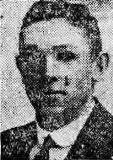
Sidney William Williams, Private, 83224, The King’s (Liverpool Regiment). Sidney was the son of Mary Williams, of 28, James Street, Pontardawe. He worked at Gilbertson’s Works prior to enlisting into the army and served with the 23rd (Works) Battalion, King’s (Liverpool) Regiment. Sidney transferred to the Labour Corps at some time, his service number changing to 131829. He remained in France after the armistice, but sadly became ill and died of pneumonia at the 1st Casualty Clearing Station on 8 February 1919, aged 26. Sidney is buried in grave X.C.6. in Mons (Bergen) Communal Cemetery, Belgium.
William Williams, Private, 200917, South Wales Borderers. William was the husband of Sadie Williams (nee Davies), of 31, Church Street, Pontardawe. He enlisted at Brecon into the Brecknockshire Battalion, South Wales Borderers and was posted to France to join the 6th Battalion, South Wales Borderers, which was attached to the 25th Division. The division moved to the Warloy area in the spring of 1916 and attacked on 3 July near Thiepval. It fought throughout the Battle of the Somme, and then moved to Ploegsteert, where it held the line for the months leading up the Battle of Messines in June 1917. The battalion carried out much work in terrible conditions during the month preceding the launching of the Battle of Messines, and on 9 June 1917 was at work on the Messines to Wytschaete Road when William was wounded by shrapnel. He died of his wounds at Bailleul later that day, aged 29. William is buried in grave III.C.150. in Bailleul Communal Cemetery Extension, France.
William Philip Williams, Private, A/113, British South African Police. William was the son of William and Elizabeth Williams, of Melrose, Gelligron, Pontardawe. He emigrated to South Africa in about 1912, and lived there until enlisting into the British South African Police, which was a Rhodesian unit, formed to patrol rural areas. The Rhodesians carried out incursions against German held territories from December 1915. William was killed in action during the campaign in German East Africa, on 13 November 1916, aged 27. He is buried in grave VIII.A.5. in Iringa Cemetery, Tanzania.
George Henry Wilson, Private, 11371, Welsh Regiment. George was born at Islington, the son of David and Jeannie Wilson. He resided with his brother at Cwmshon Villa, Pontardawe prior to the war, and worked at Hedley’s Colliery, Gwaun-cae-Gurwen as a collier. George enlisted at Cardiff into the 8th Battalion, Welsh Regiment, which was the Pioneer battalion to the 13th (Western) Division. Towards the end of February, the entire Division concentrated at Blackdown in Hampshire, and on 13 June 1915 the Division sailed to Alexandria. By 4 July, all units had moved to Mudros, preparatory for landing on Gallipoli. Between 6 and 16 July 1915 the Divisional infantry landed on Cape Helles and relieved the 29th Division. They left and returned to Mudros at the end of the month, and the entire Division landed at ANZAC Cove between 3 and 5 August, 1915, taking part in the Battles of Sari Bair. George was killed here on 8 August 1915. He was 27 years old, and is commemorated on the Helles Memorial, Gallipoli.
World War 2, 1939-1945
Edward Terence Ashmore, Guardsman, 2733944, Welsh Guards. Edward was the son of Edward and Jessie Olivira Ashmore, of Pontardawe. He married Annie Eileen Taylor, of Bute Docks, Cardiff, in 1938. Edward served with the 1st Battalion, Welsh Guards. The battalion had been almost wiped out during the fall of France in 1940 and did not return to action until landing in Normandy in June 1944 after being converted into an armoured unit, attached to the Guards Armoured Division. The battalion saw heavy fighting around Caen before taking part in the drive through Northern France through Belgium and into Holland. Edward was killed during heavy fighting around the town of Hechtel on 10 September 1944, aged 29, just a week prior to the launching of Operation Market Garden. He is buried in plot IV, row A, grave 6 in Leopoldsburg War Cemetery, Belgium.
Peter Ballard, Private, 6032185, Duke of Wellington’s (West Riding Regiment). Peter was the son of Peter and Sarah Jane Ballard, of Pontardawe. He served with the 1st Battalion, Duke of Wellington’s (West Riding Regiment), which had taken part in the retreat to Dunkirk in 1940, forming part of the rearguard, covering the evacuation of the BEF. In 1942 the battalion landed in North Africa and took part in several battles, notably at Djebel Bou Aoukaz in 1943. The following year it participated in the landing at Anzio and subsequently saw some of the most desperate fighting of the war, particularly at Monte Ceco in October 1944, where Private Richard Burton was awarded a Victoria Cross. Peter was killed in action two days after Burton gained his award, on 10 October 1944, aged 20. He is buried in plot V, row A, grave 21 in Faenza War Cemetery, Italy.
Sarah Canning, Civilian. Sarah was the daughter of Thomas and Alice Canning, of 43 Derwen Road, Alltwen. She lived alone at 41, St. Helen’s Road, Swansea. She was killed in her home during the first night of the infamous three-day blitz on Swansea, on 19 February 1941, aged 44. Her body was not discovered until 26 February 1941. She does not appear to be commemorated locally.
Cyril Davies, Flight Sergeant, 1272062, Royal Air Force Volunteer Reserve. Cyril was the son of William Davies and Mary Davies (nee Bowen) of Pontardawe. He enlisted into the Royal Air Force Volunteer Reserve and had survived being shot down in the Atlantic and again in the Indian Ocean, before being rescued and taken to Cape Town for treatment, following his second ordeal. He died of meningitis at Cape Town on 28 April 1944, aged 31, and is buried in the military allotment, grave 95994C, in Cape Town (Maitland) Cemetery, South Africa.
Dewi Davies, Sergeant, 1381324, Royal Air Force Volunteer Reserve. David, known as Dewi, was the son of David and Mabel Davies, of Ynysmeudwy, Pontardawe. He enlisted into the Royal Air Force Volunteer Reserve and was posted to the Far East with 113 Squadron, Royal Air Force. The squadron had seen action in North Africa before being deployed to Burma, and flew the Bristol Blenheim. On 11 October 1942 Dewi was serving as a wireless operator/ air gunner aboard Blenheim Z9598, which was carrying out gunnery training, when the aircraft struck a tree while low flying. Dewi and all his fellow crew members were killed in the crash. Dewi was 22 years old and is buried in plot 4, row A, grave 15 in Delhi War Cemetery, India.
Ernest Morton Gwynne Davies, Sergeant (Wireless Operator/Air Gunner), 915315, Royal Air Force Volunteer Reserve. Ernest was the son of John Albert and Anne Davies, of Pontardawe. He enlisted into the Royal Air Force Volunteer Reserve and after training as a wireless operator/ air gunner, was posted to 104 Squadron, Royal Air Force. The squadron reformed on 1 April 1941 at RAF Driffield, equipped with the Vickers Wellington. Ernest was sent with a detachment from the squadron to Malta in October 1941. Ernest was killed during a German air-raid on Malta on 22 October 1941, aged 27. He is buried in the Protestant section, plot F, grave 63, in Capuccini Naval Cemetery, Malta.
Thomas Victor Davies, Craftsman, 7651798, Royal Electrical and Mechanical Engineers. Thomas lived at Penybank, Cilmaengwyn, Pontardawe. He was educated at Pontardawe Grammar School before enlisting into the Royal Electrical and Mechanical Engineers and was posted to the Far East. Thomas died as a prisoner of war of the Japanese on 17 August 1943, aged 24. He is buried in plot B4, row C, grave 10 in Thanbyuzayat War Cemetery, Myanmar.
James David Doyle, Lance Corporal, 3910693, Essex Regiment. James was the son of John Doyle and Lillian Doyle (nee Morris), of Llanelli. He married Rosalie Louvaine Williams at Llanelli in 1938 and the couple lived at Pontardawe. James enlisted into the army and was posted to the 5th Battalion, Essex Regiment, which was attached to the 8th Indian Infantry Division. The division took part in the North African campaign, before taking part in the invasion of Italy. James was killed during heavy fighting north of the Sangro River on 27 December 1943, aged 26. He is buried in plot XVII, row C, grave 34 in Sangro River War Cemetery, Italy.
John Doyle, Ordinary Seaman, Merchant Navy. John was the son of James and Kathleen Doyle, of Ynysmeudwy, Pontardawe. He served with the Merchant Navy aboard the London registered steamship SS Empire Dorado. The ship was a member of Convoy OB239, which departed from Liverpool on 4 November 1940, but was forced to return to Oban, Argyllshire four days later after receiving reports that the German battleship Admiral Hipper was operating in the Atlantic Ocean. With the convoy scattering, Hipper called for air support, and a squadron of Focke-Wulf Fw 200 Kondors was despatched from Kiel. On 8 November 1940 Empire Dorado was spotted and attacked by German aircraft west of Ireland, killing three crew, but managed to be towed to safety. John was wounded during the attack and died on 11 November 1940, aged 20. He is buried in section I, grave 196 in Coedgwylim Cemetery, Wales. Empire Dorado sunk a year later, on 22 November 1941, following a collision with a Greek steamship.
David Ivor Evans, Pilot Officer, 67606, Royal Air Force Volunteer Reserve. David was the son of William and Harriett Maud Evans, of Trebanos. He enlisted into the Royal Air Force Volunteer Reserve and after training as a pilot was posted to 101 Squadron, Royal Air Force on 1 June 1941. On the night of 20 September 1941 David took off aboard Vickers Wellington X9922, which had been despatched as part of a force of bombers to attack Oostend. The mission was carried out successfully, but on its return trip later that night David’s Wellington became lost and descended to attempt to establish its position before crashing into the ground near Northampton, killing all but one of her crew. David was 23 years old when he died that night and is buried in section E, grave 307 in Oystermouth Cemetery, Swansea.
Evan John Evans, Lance Corporal, 3975036, Welch Regiment. Evan was the son of William and Olwen Evans, of Pontardawe. He served with the 1st Battalion, Welch Regiment. The battalion was in Palestine at the outbreak of war, attached to the 8th Division, and then joined the 6th Division in Egypt. On 18 February 1941 the battalion was assigned to CREFORCE and sent to the island of Crete, where it was decimated on 28 May, following the German airborne invasion of the island on 14 May 1941. The survivors moved back to North Africa where the battalion was rebuilt, and took part in the terrible battles around Benghazi, following Rommel’s offensive. The Welch were caught up in heavy fighting before the survivors were forced into an epic march of over 200 miles in hostile territory and under terrible conditions. After rebuilding the battalion was posted to Khartoum then returned to Palestine in March 1943 to train in beach landings. The battalion landed at Sicily on 9 July 1943 before returning to Egypt. The battalion later landed at Taranto with the 56th (London) Division on 17 July 1944 and took part in the arduous advance northwards. Evan was killed during the attacks on the Gothic Line on 11 September 1944, aged 25. He is buried in plot XIX, row L, grave 9 in Coriano Ridge War Cemetery, Italy.
Ieuan Thomas Evans, Private, 4076084, Dorsetshire Regiment. Ieuan was born on 1 March 1915, the son of Lewis Evans and Mary Evans (nee Lloyd), of 2, Penydarren Road, Pontardawe. He enlisted into the army soon after the outbreak of war and was posted to the 4th Battalion, Dorsetshire Regiment. The battalion was a Territorial Army unit, and became attached to the 130th Infantry Brigade, 43rd (Wessex) Infantry Division. Before it became ready to go to France, the evacuation from Dunkirk was underway, so the division remained on Home Service until landing in Normandy on 24 June 1944, when it joined the terrible fighting at Hill 112, Operation Jupiter. After a short rest the division launched an attack towards Mont Pinçon as part of Operation Bluecoat, which began on 30 July. The division attacked enemy positions at Briquessard and advanced through Cahagnes towards Ondefontaine. Ieuan was killed in action during the terrible fighting here, on 2 August 1944. The 29-year-old was originally buried at La Bigne, but in October 1945 the graves in the area were exhumed and re-interred in Hottot-Les-Bagues War Cemetery, France.
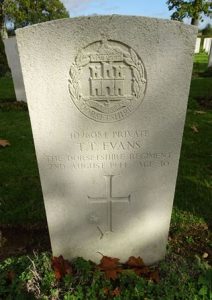
John Vernon George, Able Seaman, D/JX 289598, Royal Navy. John was born at Pontardawe on 19 August 1920, the son of William and Mary George. He enlisted into the Royal Navy and was posted to HMS President III. John was then posted aboard the refrigerated steamship SS Clan McArthur. On 11 August 1943 Clan McArthur was some 350 miles east of Madagascar, on route from Glasgow to Durban and sailing in Convoy DN-55, when she was torpedoed and sunk by the German submarine U-181, sinking with the loss of 52 of her crew of 151. John was 23 years old when he died during the sinking and is commemorated on panel 79 of the Plymouth Naval Memorial, Devon.
John Francis Gilbertson, Major, 76477, Royal Artillery. John was the son of Charles Geoffrey Gilbertson and Ellen Christabel Gilbertson (nee Moore-Gwyn), of Pontardawe. He married Eileen Muriel Thompson, of Worcester, in 1940 and the couple set up home at Gellygron, Pontardawe. John served with 105 Battery, 31 Field Regiment, Royal Artillery. He saw service with the battery during the North African campaign and then during the invasion of Italy. John was killed during the fighting to breach the Gothic Line, on 3 September 1944, aged 28. He is buried in plot II, row H, grave 12 in Montecchio War Cemetery, Italy.
John Nicholas Greenland, Stoker 1st Class, D/KX 145808, Royal Navy. John was the son of Benjamin Greenland and Ruth Greenland (nee Nicholas), of Pontardawe. He enlisted into the Royal Navy and was posted aboard HM Landing Craft Tank 339. John took part in the seaborne invasion of Italy in 1943. He survived the campaign in Italy, but died after the surrender of the German forces there, on 14 June 1945, aged 24. John is buried in plot III, row A, grave 9 in Udine War Cemetery, Italy.
David Gwilym Hodge, Leading Aircraftman, 1277888, Royal Air Force Volunteer Reserve. David was the son of John Thomas Hodge and Elizabeth Ann Hodge (nee Thomas), of Ynysmeudwy. He enlisted into the Royal Air Force Volunteer Reserve and was posted to No 8 Anti-Aircraft Cooperation Unit, at RAF Pengam Moors. On 17 December 1942 David was flying aboard an Airspeed Oxford, Serial L9696, which was carrying out a flight to train anti-aircraft gunners, when the aircraft collided with power lines near Nailsea, in Somerset, and crashed. David was 20 years old when he died in the crash and is buried west of the church in St. Mary’s Churchyard, Ynysmeudwy.
William Howells, Private, 5122665, Durham Light Infantry. William was the son of Morgan John and Rachel Howells, of Pontardawe. He enlisted into the army and was posted to the 9th Battalion, Durham Light Infantry. The battalion fought in North Africa with the 50th (Northumbrian) Division before taking part in the invasion of Sicily, Operation Husky, from 9 July 1943. William was killed during heavy fighting on 16 July 1943, aged 34. He is buried in plot IV, row G, grave 10, in Syracuse War Cemetery, Sicily.
Brinley James, Driver, 2344829, Royal Corps of Signals. Brinley was the son of Thomas James and Frances James (nee John), of Pontardawe. He married Dorothy May Garbert, of Dorking, Surrey, in 1933. Brinley enlisted into the army and was posted to the 46th Division Signals, Royal Corps of Signals, and saw service with the division in North Africa and in the invasion of Italy. He died during the terrible fighting to break the Gustav Line on 14 February 1944, aged 29. Brinley is buried in plot I, row E, grave 8 in Minturno War Cemetery, Italy.
Richard Jenkins, Private. Richard cannot presently be identified.
Albert Jeremiah, Aircraftsman 1st Class, 1415942, Royal Air Force Volunteer Reserve. Albert was the son of Benjamin and Queenie Jeremiah, of Pontardawe. He enlisted into the Royal Air Force Volunteer Reserve. Albert was killed in an accident when he was struck by a trolley bus at Leytonstone on 7 September 1942, aged 19. He is buried north of the church porch in St. Peter’s Churchyard, Pontardawe.
Glyn John, Sergeant, 1316412, Royal Air Force Volunteer Reserve. Glyn was the son of George and Margaret Jane John, of Trebanos. He enlisted into the Royal Air Force Volunteer Reserve and trained as a wireless operator/ air gunner before being posted to 100 Squadron, Royal Air Force, which was based at RAF Waltham, near Grimsby. On the night of 1/2 January 1944 Glyn took off in Lancaster Mk III serial number JB740, which was bound for Berlin as part of a force of 421 Lancasters. The aircraft was lost outbound early in the morning of 2 January 1944 at Rottorf, Germany, killing all her crew. Glyn was 22 years old when he was killed in the crash and is buried alongside his fellow crew members in plot 6, row J, collective grave 1-7 in Hanover War Cemetery, Germany.
Daniel Jones, Private. Daniel cannot presently be identified.
Elfed Jones, Signalman, 2336678, Royal Corps of Signals. Elfed was the son of Evan and Mary Anna Jones, of Pontardawe. He enlisted into the army and was posted to the Far East with the 18th Division Signals, Royal Corps of Signals. Elfed was taken prisoner by the Japanese during their invasion of Malaya and Singapore, and died in captivity on 24 December 1943, aged 26. He is buried in plot 2, row G, grave 35 in Kanchanaburi War Cemetery, Thailand.
Jeffrey Jones, Craftsman, 10545918, Royal Electrical and Mechanical Engineers. Jeffrey was the son of David Charles and Elizabeth Ann Jones, of Alltwen. He served with the 9th Armoured Brigade Group Workshops, Royal Electrical and Mechanical Engineers. Jeffrey survived the war but died on 23 October 1946, aged 25. He is buried south-west of the chapel, in row 3, grave 7 in Alltwen Welsh Congregational Chapelyard. Jeffrey does not appear to be commemorated locally.
Vernon Llewelyn Bowen Jones, Flying Officer, 133632, Royal Air Force Volunteer Reserve. Vernon was the son of Hopkin and Margaretta Jones, of Pontardawe. He married Betty Davies in 1943. Vernon enlisted into the Royal Air Force Volunteer Reserve and trained as a pilot before being posted to 100 Squadron, Royal Air Force. The squadron had been almost wiped out during the fall of Singapore before returning to Britain to reform as a heavy bomber squadron, equipping with the Avro Lancaster. Vernon crashed landed his Lancaster ND388 on 21 February 1944 whilst returning from a raid. Three nights later he took off from RAF Grimsby, flying Lancaster JB604, to join a force of 734 aircraft made up from 460 Lancasters, 169 Halifaxes and 11 Mosquitoes, which had been ordered to destroy a German ball bearing factory. Vernon’s Lancaster was hit by either flak or by a German night-fighter and caught fire, so he ordered his crew to bale out. Only two men managed to escape the stricken aircraft, which blew up and crashed at Marly, some six km from Metz, France, killing Vernon and four of his crew. Vernon was just 22 years old when he was killed that night and is buried alongside his crew in grave 4 in Marly Communal Cemetery, France.
William Maxwell Jones, Gunner, 4205592, Royal Artillery. William was the son of Thomas William and Bertha Jones, of Pontardawe. He married Nancy Maddock, of Ebbw Vale, in 1940. William served with 381 Light Anti-Aircraft Battery, Royal Artillery. William died on 1 December 1943, aged 32. He is buried west of the chapel in the Welsh Congregational Chapelyard at Alltwen.
William Raymond Jones, Third Officer, Merchant Navy. William was the son of Henry Lloyd Jones and Margaret Ann Jones, of Trebanos. He served with the Merchant Navy aboard the Cardiff registered steamship SS Rose Schiaffino. The ship had been captured from the French off Gibraltar on 29 January 1941 and transferred to the Ministry of War Transport for use by the British. She had joined Convoy SC-51 later that year, but became a straggler and returned to St. John’s, Newfoundland before sailing independently towards the end of October 1941. At 09.03 on 31 October 1941 the helpless ship was struck by a torpedo from the German submarine U-374 and sank quickly, with the loss of her master, 36 crew members and four DEMS gunners. William was just 19 years old when he died during the sinking, and is commemorated on panel 88 of the Tower Hill Memorial, London.
Richard Clyde Kingdon, Gunner, 1517924, Royal Artillery. Richard was the son of Thomas Henry Kingdon and Agnes Kingdon (nee Wyatt), of Cilybebyll. He served with 16th Battery, L. H. Anti-Aircraft Regiment, Royal Artillery. Richard’s battery was in France with the BEF following the German Blitzkrieg and got caught up in the heavy fighting which followed. Richard was killed at sometime between 31 May and 2 June 1940, following the surrender of the Belgian Army. The 21-year-old has no known grave and is commemorated on column 13 of the Dunkirk Memorial, France.
Glyndwr John Lewis, Gunner, 1552555, Royal Artillery. Glyndwr was the son of Owen Lewis and Emma Lewis (nee Woolley), of Pontardawe. He served with 65 Battery, 34 Light Anti-Aircraft Regiment, Royal Artillery, which had its HQ at Swansea. Glyndwr died in the Neath district on 29 April 1941, aged 25. He is buried in St. Ciwg Churchyard, Llanguicke.
Thomas Lewis, Gunner, 1091180, Royal Artillery. Thomas was the son of William and Mary Lewis and the husband of Glythen Lewis, of Alltwen. He served with 107 (The South Notts. Hussars) Regiment, Royal Artillery. The regiment moved to Palestine after the outbreak of war, before being moved to Egypt, and served at Mersa Matruh, the Suez Canal and Tobruk, where the regiment supported the Australians. The regiment was virtually annihilated during the Battle of Knightsbridge, where it covered the retreat of the British Army during the Battle of Gazala, which proved to be Rommel’s greatest victory. Thomas was killed during the battle, on 6 June 1942, aged 32. He has no known grave and is commemorated on column 14 of the Alamein Memorial, Egypt.
William Arthur Lofthouse, Sergeant, 751506, Royal Air Force Volunteer Reserve. William was born in Merthyr in 1918, the son of Arthur George and Mabel Amanda Lofthouse (nee Gill). His mother appears to have died soon after William was born, and his father moved to her native Pontardawe, where he married Eva Cann in 1923. William worked as an articled clerk prior to enlisting into the Royal Air Force Volunteer Reserve and served with 10 Squadron, Royal Air Force, which was a night bomber unit which formed part of No. 4 Group of RAF Bomber Command. By the beginning of the war the squadron was equipped with the Armstrong Whitworth Whitley, based at RAF Dishforth, but on 8 July 1940 moved to RAF Leeming, in Yorkshire. William was one of four men killed when their Whitley was brought down over Germany on 22 October 1940. William was 21 years old and is buried in collective grave 1.G.25-28 in Durnbach War Cemetery, Germany. William does not appear to be commemorated at Pontardawe.
William Michael McGarry, Flight Sergeant, 1379359, Royal Air Force Volunteer Reserve. William was the son of Thomas and Catherine Ann McGarry, of Pontardawe. He served with 15 O.T.U., Royal Air Force, which was stationed at RAF Harwell at the outbreak of war. The Squadron flew the Vickers Wellington Bomber in an operational training mode, and during 1940 and 1941 flew propaganda missions over France, and then flew bombing missions over Bremen, Cologne and Essen. The airfield came under attack of the Luftwaffe during August and September 1941 and the Squadron were forced to move temporarily to RAF Mount Farm while their runways were being repaired. William’s Wellington IC, serial R1783 took from RAF Mount Farm at 19.05 on the night of 14 October 1941 tasked to fly to Orleans and Dreux on Nickeling duties, and due to enemy action crashed at Berville (Eure) 18km East of Lisieux, that night, killing all aboard. William, who was 28 years old, is buried in grave 5 in Barville Churchyard, France, alongside his comrades.
David Morgan, Lance Corporal, 14731223, Welch Regiment. David was the son of Thomas and Mary Ann Morgan, of Alltwen. He served with the 4th Battalion, Welch Regiment, which was attached to the 53rd (Welsh) Division. The division trained in Northern Ireland and England for much of the war before landing on the Normandy beach-head at the end of June 1944. The divisions first major actions came during the Battle of the Falaise Gap, where it saw heavy fighting, before taking part in the drive northwards through Northern France through Belgium and into Holland, where the division famously liberated the town of s’Hertogenbosch. The division then took part in the Battle of the Bulge, before clearing the Reichswald Forest before coming up against the Siegfried Line. David was killed during the crossing of the Rhine near Xanten, on 27 March 1945, aged 19. He is buried in plot 47, row H, grave 7 in Reichswald Forest War Cemetery, Germany.
William Kerr Morgan, Private, 3971746, Welch Regiment. William was the son of William and Rosina Morgan, of Pontardawe. He served with the 1st Battalion, Welch Regiment. The battalion was in Palestine at the outbreak of war, attached to the 8th Division, and then joined the 6th Division in Egypt. On 18 February 1941 the battalion was assigned to CREFORCE and sent to the island of Crete, where it was decimated on 28 May, following the German airborne invasion of the island on 14 May 1941. The survivors moved back to North Africa where the battalion was rebuilt, and took part in the terrible battles around Benghazi, following Rommel’s offensive. The Welch were caught up in heavy fighting before the survivors were forced into an epic march of over 200 miles in hostile territory and under terrible conditions. After rebuilding the battalion was posted to Khartoum then returned to Palestine in March 1943 to train in beach landings. The battalion landed at Sicily on 9 July 1943 before returning to Egypt. The battalion later landed at Taranto with the 56th (London) Division on 17 July 1944 and took part in the arduous advance northwards. William was killed near Croce on 3 October 1944, aged 25. He is buried in plot XV, row D, grave 3 in Coriano Ridge War Cemetery, Italy.
Melvyn Bertram Parratt, Able Seaman, D/JX 134827, Royal Navy. Melvyn was the son of Smith Watkinson Parratt and Esther Parratt, of Pontardawe. He served with the Royal Navy and was posted aboard HM Submarine Thames. She was stationed at Malta upon the outbreak of war and was recalled to home waters, joining the 2nd Submarine Flotilla. Thames served in the North Sea with the 9th Submarine Flotilla during the Norwegian campaign, and in July 1940 torpedoed and sank the German torpedo boat Luchs, which was one of the escort fleet for the damaged German battleship Gneisenau that was on route from Trondheim to Kiel. Thames was reported overdue on 3 August 1940, after having most likely struck a mine off Norway. Melvyn was 25 years old when he died in the loss of Thames, and is commemorated on panel 38, column 1 of the Plymouth Naval Memorial, Devon.
Hubert Wilson Godfrey Jones Penderel, MC, AFC, Group Captain, Royal Air Force. Hubert was born on 7 October 1890 at Llandeilo, the son of Thomas and Elizabeth Jones, later of Garth, Pontardawe, Swansea. Hubert was commissioned into the 4th Welsh on 17 April 1913, and served during the Great War with them, before transferring into the Royal Flying Corps, qualifying as a Pilot in 1916. The RFC reformed and merged with the RNAS in France in 1917 to form the Royal Air Force, and Hubert then saw out the war with the RAF, gaining the Military Cross and the Italian Silver Medal for Military Valour in 1917. On 1 July 1918 he was promoted to Major and was granted a permanent RAF Commission. He was promoted Squadron Leader in 1925, Wing Commander in 1933 and Group Captain in 1938. Hubert was killed whilst flying Hurricane HV895 over Orfordness, Suffolk on 14 May 1943, aged 52, and is buried at Llanguicke (St. Ciwg) Churchyard, Glamorgan.
David Lemuel Phillips, Private, 3972330, Welch Regiment. David was the son of William Henry and Annie Phillips, of Pontardawe and was the husband of Elizabeth Clementine Mary Phillips, of Canterbury. David served with the 70th Battalion, Welch Regiment, which was a home service unit. He died in the Cambridge area on 16 April 1943, aged 22. His body was brought home for burial in row c, grave 2 in Ebenezer Congregational Chapelyard, Rhos.
John William Plummer, Gunner, 1532006, Royal Artillery. John was the husband of Elsie Elizabeth Plummer, of Pontardawe. He served with 41 Battery, 15 Light Anti-Aircraft Regiment, Royal Artillery. The battery was armed with Bofors guns and in November 1940 embarked for the Middle East, seeing action in North Africa before joining the Desert Rats in 1942 and taking part in the advance which drove Rommel out of North Africa. John was killed during a German counter-offensive on 28 November 1942. He was 32 years old and is buried in plot 2, row D, grave 25 in Benghazi War Cemetery, Libya.
John Leonard Powell, DFC, Squadron Leader, 103039, Royal Air Force Volunteer Reserve. John was the son of David Albert and Elizabeth Powell, of Rhos. He enlisted into the Royal Air Force Volunteer Reserve and was posted to 617 Squadron, Royal Air Force, which was the famous Dambuster Squadron, equipped with the Avro Lancaster. By early 1945 John had been promoted to Squadron Leader and on 16 April 1945 led a raid to attack and attempt to sink the German cruiser Lutzow, which was at anchor in the Kiel Canal, being used as artillery to support the German defence against the advancing Russian army. John was flying Lancaster I, Serial NG228, in a fourteen-bomber raid, taking off from RAF Woodhall Spa at 13.49. The Lutzow was thought to have been damaged by one of the massive bombs dropped during the raid, but the aircraft encountered heavy flak and John’s Lancaster had a wing blown off and spun into the ground near the target area, killing all her crew. John, who was 29 years old, was initially buried with his crew at Swinemunde, but their graves were later relocated, and he now lies in plot 5, row B, collective grave 1-5 in Poznan Old Garrison Cemetery, Poland. John was posthumously awarded the Distinguished Flying Cross (DFC), effective from 15 April 1945, which was published in the London Gazette of 29 March 1946.
Glyn Stephen Price, Leading Aircraftman, 1836130, Royal Air Force Volunteer Reserve. Glyn was the son of David Stephen Price and Margaret Price, of Trebanos. He served with the Royal Air Force and had been posted to Belgium following the liberation of the country from the Germans. Glyn appears to have been among 567 people killed when a German V-2 rocket struck a Rex Cinema in Antwerp on 16 December 1944, during the screening of Gary Cooper’s film, The Plainsman. Glyn was just 19 years old when he was killed that day and is buried in plot V, row D, grave 34 in Schoonselhof Cemetery, Antwerp, Belgium.
Philip Henry Pritchard, Stoker 1st Class, D/KX 94319, Royal Navy. Philip was born on 27 April 1920, the son of Sidney David and Florence May Pritchard, of Godrergraig. He enlisted into the Royal Navy and was posted aboard the light-cruiser HMS Gloucester. She was a modern ship, and was initially assigned to the China Station, then transferred to the Indian Ocean and later to South Africa. She was transferred to the Mediterranean Fleet in mid-1940 and spent much of her time escorting the Malta Convoys before being assigned to Force C, which had been despatched to stem any reinforcing of the German troops which had invaded Crete. On 22 May 1941 Gloucester was off Crete when she was attacked by German dive bombers and sank with the loss of 722 men out of a crew of 807. Philip was 21 years old when he died during the sinking and is commemorated on panel 53, column 2 of the Plymouth Naval Memorial, Devon. His cousin, Richard Raymond Wesson, also fell during the war.
Morgan Gethin Probert, Private, 1492867, Parachute Regiment. Morgan was the son of Harry and Sarah Ann Probert, of Pontardawe. He served with the 10th Battalion, Parachute Regiment, which had formed from the 2nd Battalion, Royal Sussex Regiment in the Suez Canal area in January 1943. The battalion fought in Italy before returning to England to prepare for the D-Day landings but was not used until the launching of Operation Market Garden, when it parachuted at Arnhem during the second lift on 18 September 1944. The battalion fought to virtual elimination during the ill-fated attempt to capture the Rhine crossing. Morgan was killed at Arnhem during heavy fighting against the 9th SS Panzer Division on 19 September 1944, the day after he landed. He was 26 years old and is buried in plot 15, row A, grave 17 in Arnhem Oosterbeek War Cemetery, Netherlands.
Alwyn Edward Rees, Sergeant, 1018355, Royal Air Force Volunteer Reserve. Alwyn was born at High Street, Clydach in 1910, the son of Rees Thomas Rees and Elizabeth Rees. His parents later moved to Princetown, Devon. Alwyn enlisted into the Royal Air Force Volunteer Reserve and trained as an observer before being posted to 142 Squadron, Royal Air Force, which was equipped with the Vickers Wellington, and was based at RAF Grimsby by 7 July 1942. Alwyn was killed when his Wellington was brought down over Germany during a night operation on 28 August 1942. Alwyn was 32 years old and is buried in plot 28, row B, grave 18 in Reichswald Forest War Cemetery, Germany.
Ronald Richards, Private, 3960294, Welch Regiment. Ronald was the son of William Thomas Richards and Sarah Richards, of Pontardawe. He served with the 1/5th Battalion, Welch Regiment, which was the Glamorgan Territorial battalion, attached to the 53rd (Welsh) Division. The division trained in Northern Ireland and England for much of the war before landing on the Normandy beach-head at the end of June 1944. The divisions first major actions came during the Battle of the Falaise Gap, and the 1/5th Welch took up positions on the slopes of Hill 112 facing Le Bon Repos. From 21 July 1944 the division came under the spotlight of the Germans, who launched several counter-attacks, spearheaded by Tiger tanks, and the 1/5th Welch suffered heavily before a counter-attack by the 4th Welch stopped the Germans. Ronald was killed near Le Bon Repos on 27 July 1944, aged 29. He is buried in plot VI, row C, grave 1 in Banneville-La-Campagne War Cemetery, France.
Frederick George Shields, Sergeant, 1086114, Royal Air Force Volunteer Reserve. Frederick was the son of Robert and Sarah Shields, of Pontardawe. He enlisted into the Royal Air Force Volunteer Reserve and was posted to 166 Squadron, Royal Air Force, which was stationed at RAF Kirmington. On 10 April 1944 Frederick was a crew-man aboard Lancaster ND625 which had been sent on a gardening mission, dropping mines in Sejerø Bay, off Denmark, when the Lancaster was brought down and crashed into the sea. The bodies of Frederick and two other men were recovered and buried in collective grave 3J in Odden (Overby) Churchyard, Denmark. Frederick was 31-years-old when he was killed that day.
Charles William Symonds, Signalman, 14537819, Royal Corps of Signals. Charles was the son of Martin and Susie Symonds, of 5 Thomas Street, Pontardawe. He married Regina Doreen Davies at Pontardawe in 1934. Charles served throughout the war with the Royal Corps of Signals. He survived the war but died on 10 January 1947, aged 37 and is buried in section I, grave 1292, in Coedgwilym Cemetery.
David Meurig Thomas, Sergeant, 1316660, Royal Air Force Volunteer Reserve. David was the son of Idwal Vaughan and Elizabeth Gwladys Thomas, of Pontardawe. He enlisted into the Royal Air Force Volunteer Reserve and was posted to Rhodesia to train as a pilot under the Empire Air Training Scheme. He was killed when his aircraft crashed during a training flight on 30 September 1942. David was 20 years old and is buried in grave 52 in Bulawayo (Athlone) Cemetery, Zimbabwe.
Emrys Thomas, BA, Flying Officer, 110613, Royal Air Force Volunteer Reserve. Emrys was the son of Gersome and Mary Thomas, of Alltwen, Pontardawe. He gained his BA with Honours at Swansea University prior to the war, when he enlisted into the Royal Air Force Volunteer Reserve, training as a pilot. He was commissioned as a pilot officer on 16 October 1941 and was posted to No 1 Overseas Air Dispatch Unit, Royal Air Force. On 13 July 1943 Emrys was flying a de Havilland DH.98 Mosquito FB Mk V, Serial HJ755 when it lost engine power and crashed at Fayld, near Calne, Wiltshire, killing Emrys and his observer, George Bell King. Emrys was 24 years old when he was killed in the crash, and is buried south of the chapel in Alltwen Welch Congregational Chapelyard.
Islwyn Thomas, Private, 3966263, Welch Regiment. Islwyn was the son of Jonathan and Annie Thomas, of Trebanos, Pontardawe. He served with the 1st Battalion, Welch Regiment. The battalion was in Palestine at the outbreak of war, attached to the 8th Division, and then joined the 6th Division in Egypt. On 18 February 1941 the battalion was assigned to CREFORCE and sent to the island of Crete, where it was decimated, following the German airborne invasion of the island on 14 May 1941. Islwyn was killed on 27 May 1941, just a day before the entire battalion was almost wiped out. He was 24 years old and is commemorated on face 6 of the Athens Memorial, Greece.
Thomas Arthur Vaughan, Sergeant, 2182628, Parachute Regiment. Thomas was the son of John Henry and Mary Vaughan, of Pontardawe. He enlisted into the 10th Battalion, Royal Welch Fusiliers, which was converted into an airborne unit, becoming named the 6th Battalion, Parachute Regiment, and became part of the 2nd Parachute Brigade. The brigade embarked for North Africa in April 1943 and took part in the amphibious landings on Italy in September 1943. The 6th Battalion then took part in its first combat drop into France on 15 August 1944, and saw action there before being moved to Greece, on policing duties, following the withdrawal of the German army of occupation. Thomas died in Greece on 31 December 1944, aged 39. He is buried in plot 19, row A, grave 12 in Phaleron War Cemetery, Greece.
Richard Raymond Wesson, Able Seaman, D/J 109893, Royal Navy. Richard was born at Pontardawe on 20 July 1908, the son of Harry and Lilian Wesson. He worked as a colliery boy prior to enlisting into the Royal Navy in April 1929. He married Louisa Mary James, of Harrow-on-the-Hill, Middlesex, in 1931. Richard spent the years prior to the war serving aboard some of the most famous warships in the Royal Navy: HMS Renown, HMS Hood, and HMS Malaya before joining the submarine service and was posted aboard HM Submarine Seahorse on 8 December 1937. By the outbreak of war Seahorse was a member of the 2nd Submarine Flotilla, which moved to its war station, Dundee and Blyth. On 26 December 1939 she sailed from Blyth for patrol off the east coast of Denmark, and moved towards the mouth of Elbe estuary. She did not return on her due date of 9 January 1940. Originally, she was thought to have struck a mine and sank, but she was later thought to have been depth-charged by the German First Minesweeper Flotilla on 7 January 1940. Whatever her fate, Richard is officially recorded to have been killed due to enemy action on 12 January 1940, aged 31. He has no known grave and is commemorated on panel 38, column 3 of the Plymouth Naval Memorial, Devon. His cousin, Philip Henry Pritchard, also fell.
Arthur Williams, Sergeant, 646080, Royal Air Force. Arthur was born in Pontardawe in 1921. He enlisted into the Royal Air Force and was posted to No 15 Operational Training Unit, which was based at RAF Harwell in Berkshire. On 10 July 1940 Arthur took off from Harwell aboard Avro Anson MK I, serial N5019, which had been sent on an exercise over mid Wales. At around 23.30 that night the aircraft lost its way in cloud and crashed into high ground at Mount Y Gamrhiw near Llanwrthwl, about three miles south of Rhayader, killing Arthur and three other crew-members. The pilot, who was being trained, crawled away from the wreckage to get help. Arthur was just 19-years-old when he died in the crash, and is buried in St. Ciwg Churchyard, Llanguicke.
Edward M Williams, Private, 7376076, Royal Army Medical Corps. Edward was the son of Griffith and Elizabeth Williams, of Rhos. He served with the Royal Army Medical Corps and had seen action in North Africa before his unit was moved to Sicily during Operation Husky, a large scale amphibious and airborne invasion of the island which commenced on the night of 9/10 July 1943. Edward was killed in Sicily on the first morning of the invasion, on 10 July 1943, aged 23. He is buried in plot III, row H, grave 7 in Syracuse War Cemetery, Sicily.
Gwilym Williams, DFM, Flight Sergeant, 1416530, Royal Air Force Volunteer Reserve. Gwilym was from Pontardawe and enlisted into the Royal Air Force Volunteer Reserve. He was posted to 635 Squadron, Royal Air Force, which was an elite Pathfinder squadron, equipped with the Avro Lancaster. At 17.21 on 5 March 1945, Gwilym took off from RAF Downham Market aboard Lancaster PB921, which was part of a large force of 760 aircraft ordered to bomb the German town of Chemnitz, and the Siegmar tank engine factory. Cold weather caused the loss of nine aircraft early in the raid, while twenty-two more were lost during the raid itself. Lancaster PB921 was among the aircraft lost during the raid that night. Gwilym and six of his fellow crew-members were killed during the loss of their aircraft on 5 March 1945 and are all commemorated on the Runnymede Memorial. Gwilym’s name can be found on panel 273. He was retrospectively awarded the Distinguished Flying Medal in the London Gazette of Tuesday 12 February 1946, the award of which was stated to be in effect from 4 March 1945.
Islwyn Williams, Sergeant, 3967901, Welch Regiment. Islwyn was born in Pontardawe in 1915. He served with the 1st Battalion, Welch Regiment. The battalion was in Palestine at the outbreak of war, attached to the 8th Division, and then joined the 6th Division in Egypt. On 18 February 1941 the battalion was assigned to CREFORCE and sent to the island of Crete, where it was decimated on 28 May, following the German airborne invasion of the island on 14 May 1941. The survivors moved back to North Africa where the battalion was rebuilt, and took part in the terrible battles around Benghazi, following Rommel’s offensive. The Welch were caught up in heavy fighting before the survivors were forced into an epic march of over 200 miles in hostile territory and under terrible conditions. Islwyn died on 28 February 1942, sometime during this march. The 28-year-old has no known grave and is commemorated on column 63 of the Alamein Memorial, Egypt.
John Eynon Williams, Driver, 2152763, Royal Engineers. John was the son of Thomas and Blodwen Williams, of Pontardawe. He served with 107 Field Company, Royal Engineers, which moved to North Africa in 1942. John died on 22 June 1943, just over a month after the surrender of the Axis forces in North Africa on 13 May 1943. He was 28 years old and is buried in plot I, row B, grave 15 in Enfidaville War Cemetery, Tunisia.
Morgan S H Williams, Guardsman. Morgan cannot presently be identified, apart from the fact that he was born in the Pontardawe district in the December 1923 quarter.
Rees John Williams, Carpenter, Merchant Navy. Rees was born on 18 January 1913, the son of Rees and Mary H. Williams, of Pontardawe. He married Winifred Lewis in 1931 and the couple lived at 69, High Street, Pontardawe. Rees served with the Merchant Navy during the war and by 1942 was serving aboard the London registered steamer, SS Empire Wagtail. She was an American ship which had been transferred to Britain in 1941. Late in 1942 Empire Wagtail left Cardiff for Halifax, Nova Scotia, with a cargo of coal, joining Convoy ONS-154. During the night of 28 December 1942, the Convoy was located about 900 miles west of Cape Finisterre when it was attacked by the German submarine U-260, which fired a spread of torpedoes into the Convoy. Empire Wagtail was hit and sank with the loss of her master, 35 crew and eight gunners. Rees was 29 years old when he died in the sinking. He is commemorated alongside his fellow crew-members on panel 47 of the Tower Hill Memorial, London.
Sidney Williams, Private, 13045967, Pioneer Corps. Sidney was the son of John and Alice Williams, of Pontardawe. He served with the Auxiliary Militia, Pioneer Corps. Little is known of him, but his death was registered in Thurrock, Essex on 25 October 1940. Sidney was 26 years old and is buried south of the chapel in Alltwen Welsh Congregational Chapelyard, Wales.
William Richard Williams, Private, 3976984, Monmouthshire Regiment. William was the son of William and Henrietta Williams, of Trebanos. He served with the 2nd Battalion, Monmouthshire Regiment, which was attached to the 53rd (Welsh) Division. The division trained in Northern Ireland before moving to England where training intensified prior to D-Day and was sent to Normandy at the end of June 1944. The Monmouths spent two unpleasant weeks holding a position called Hill 112 before taking part in the Battle of the Falaise Gap, which opened the way to Paris for the Allies. William was killed during the height of the battle, on 15 August 1944, aged 21. He is buried in plot XI, row F, grave 4 in Banneville-La-Campagne War Cemetery, France.